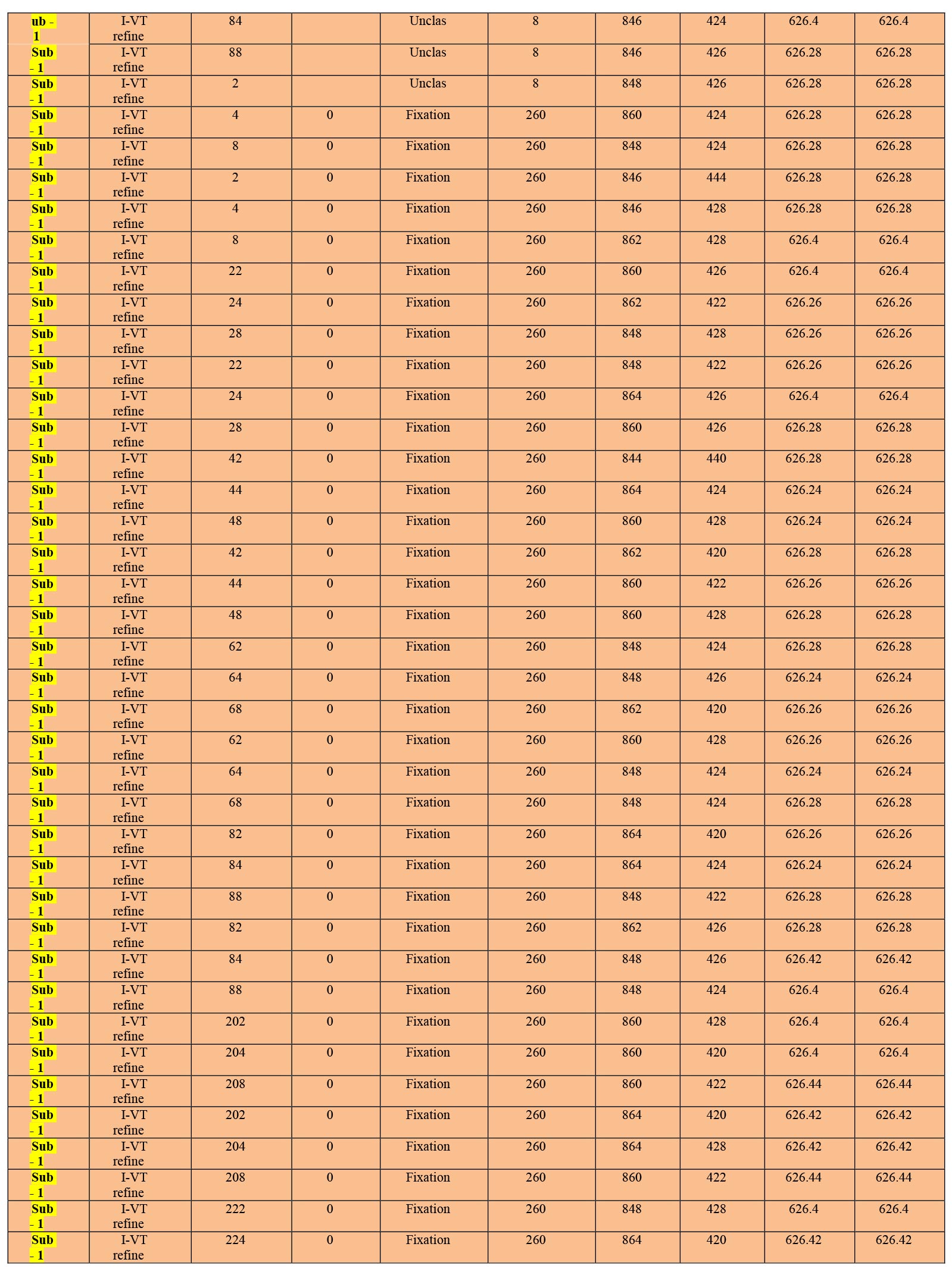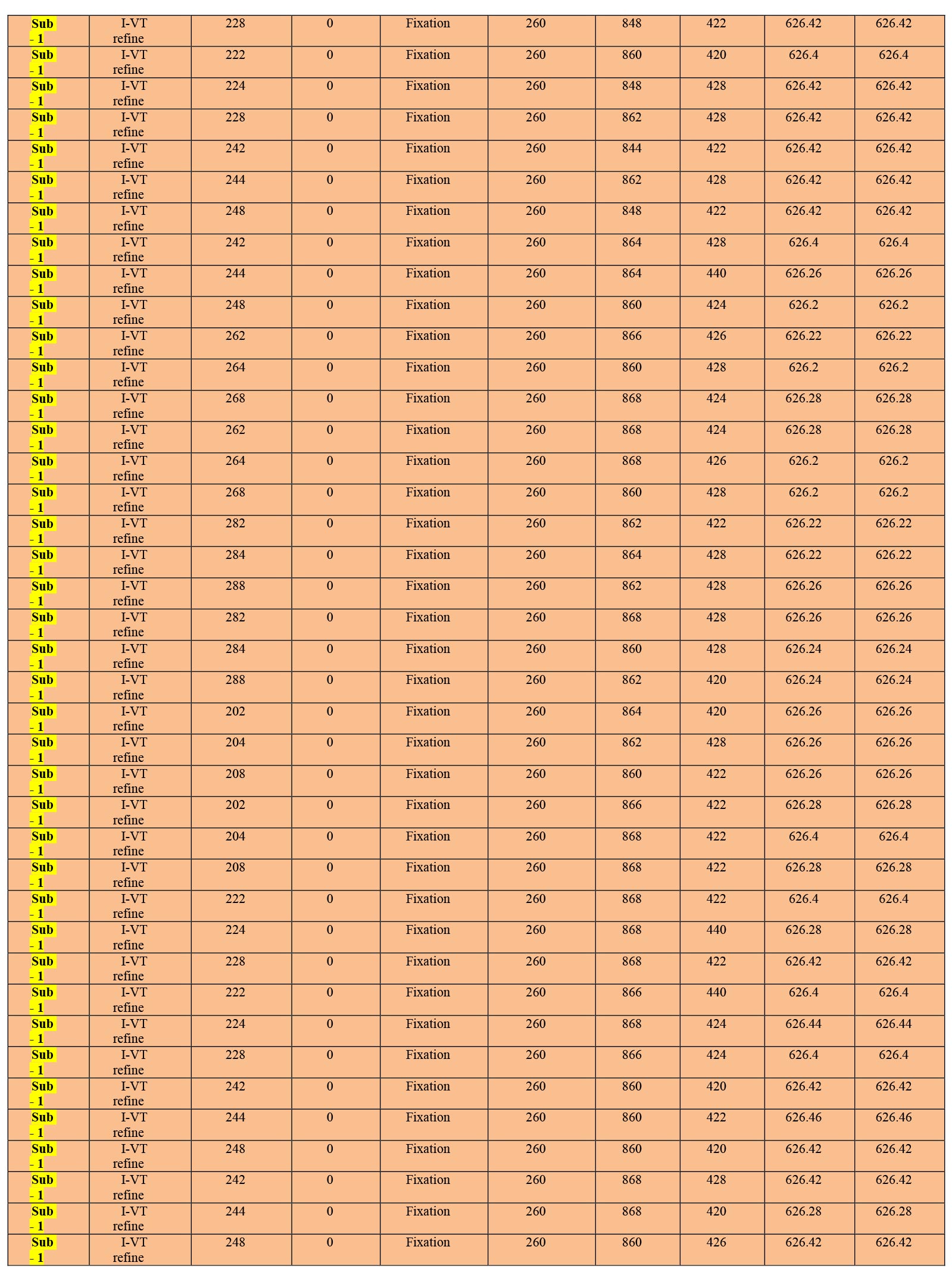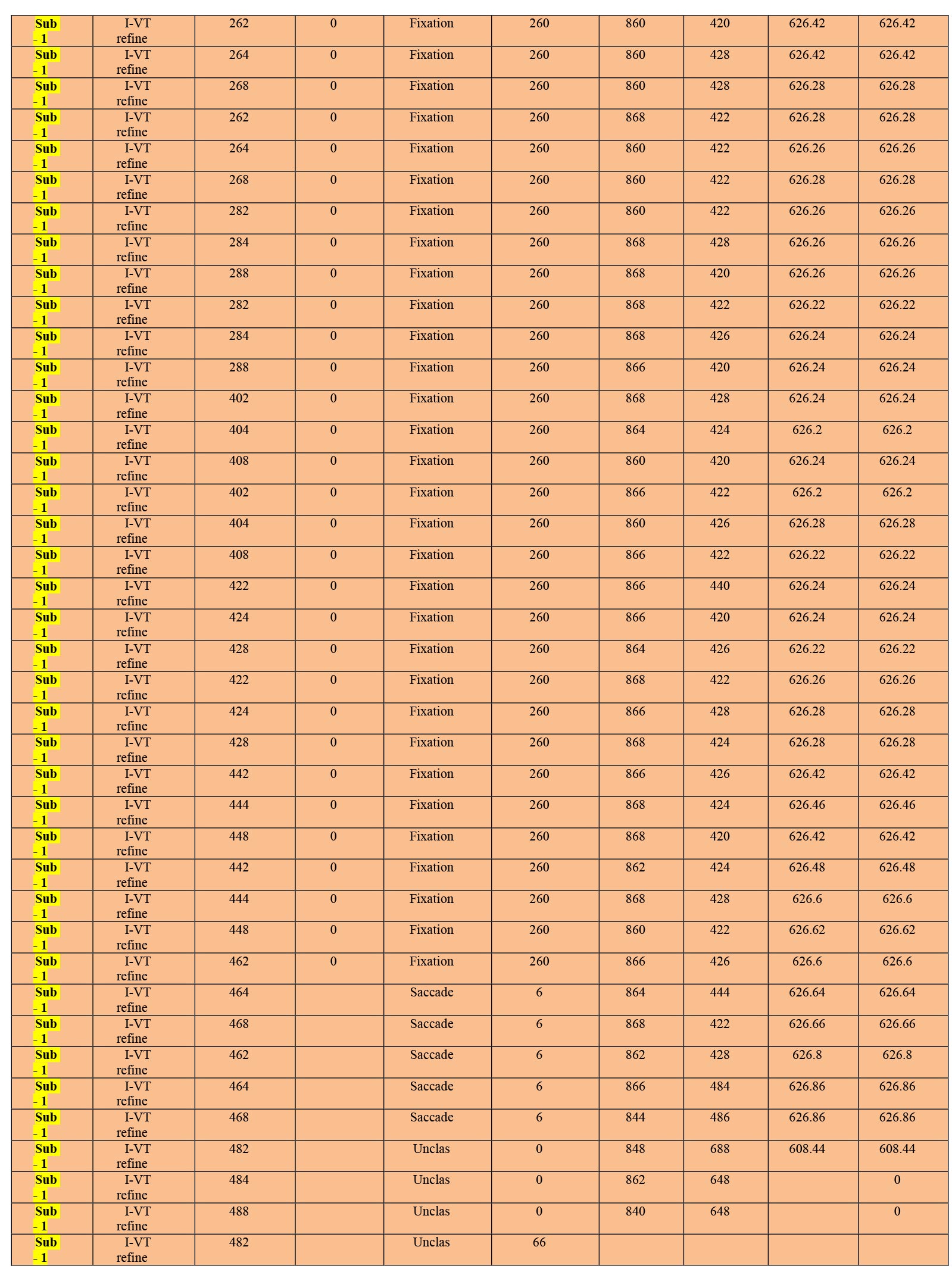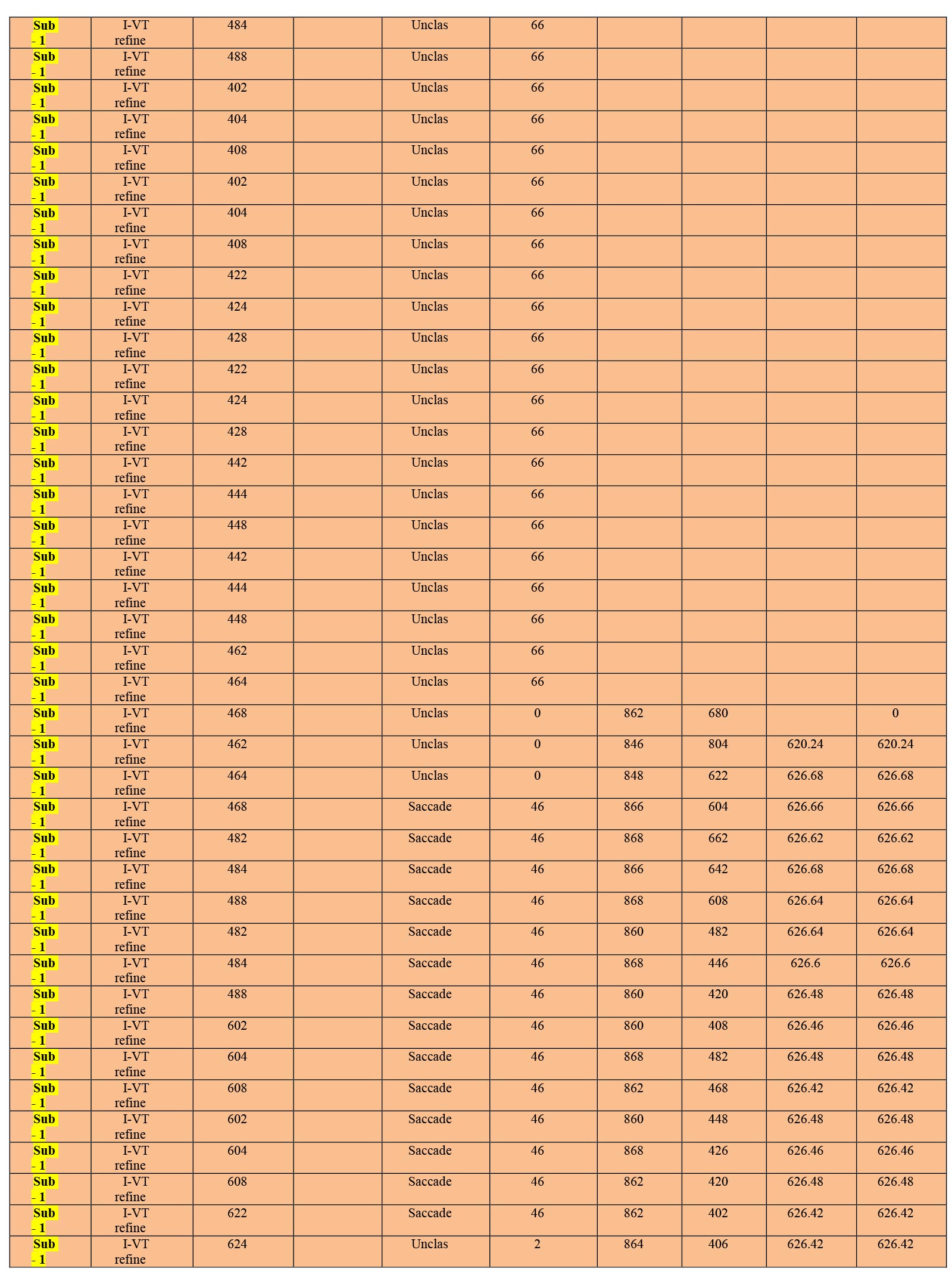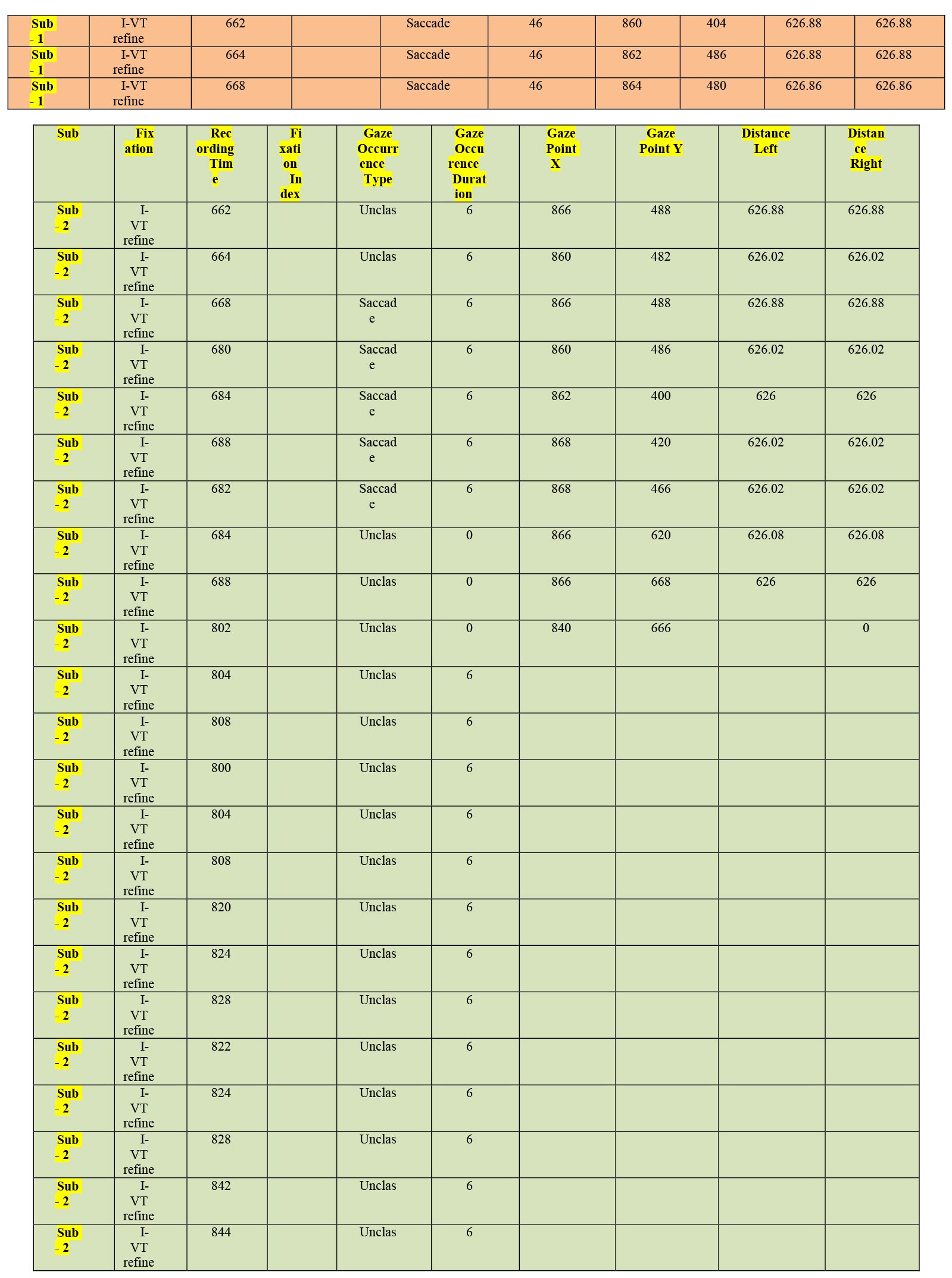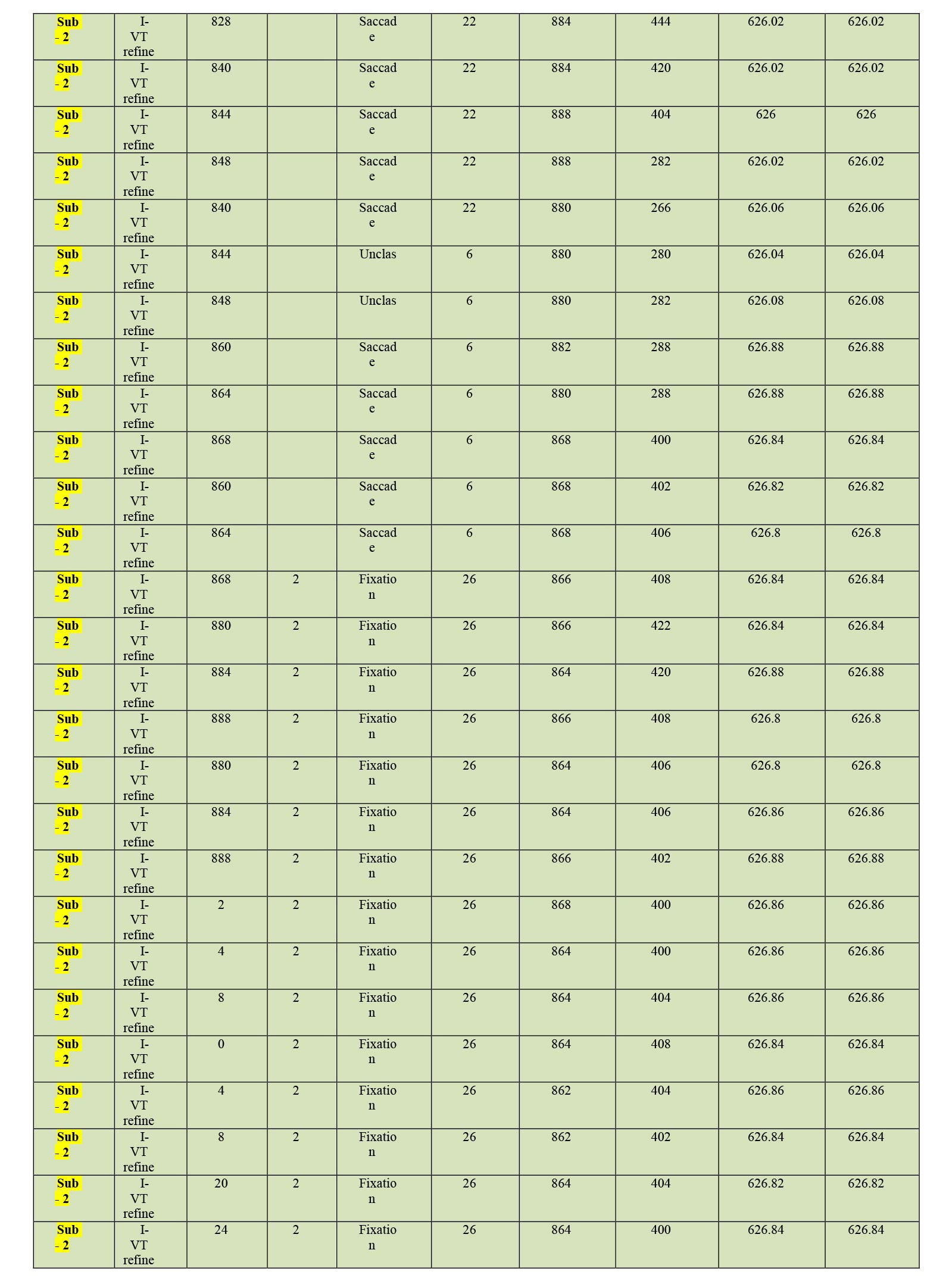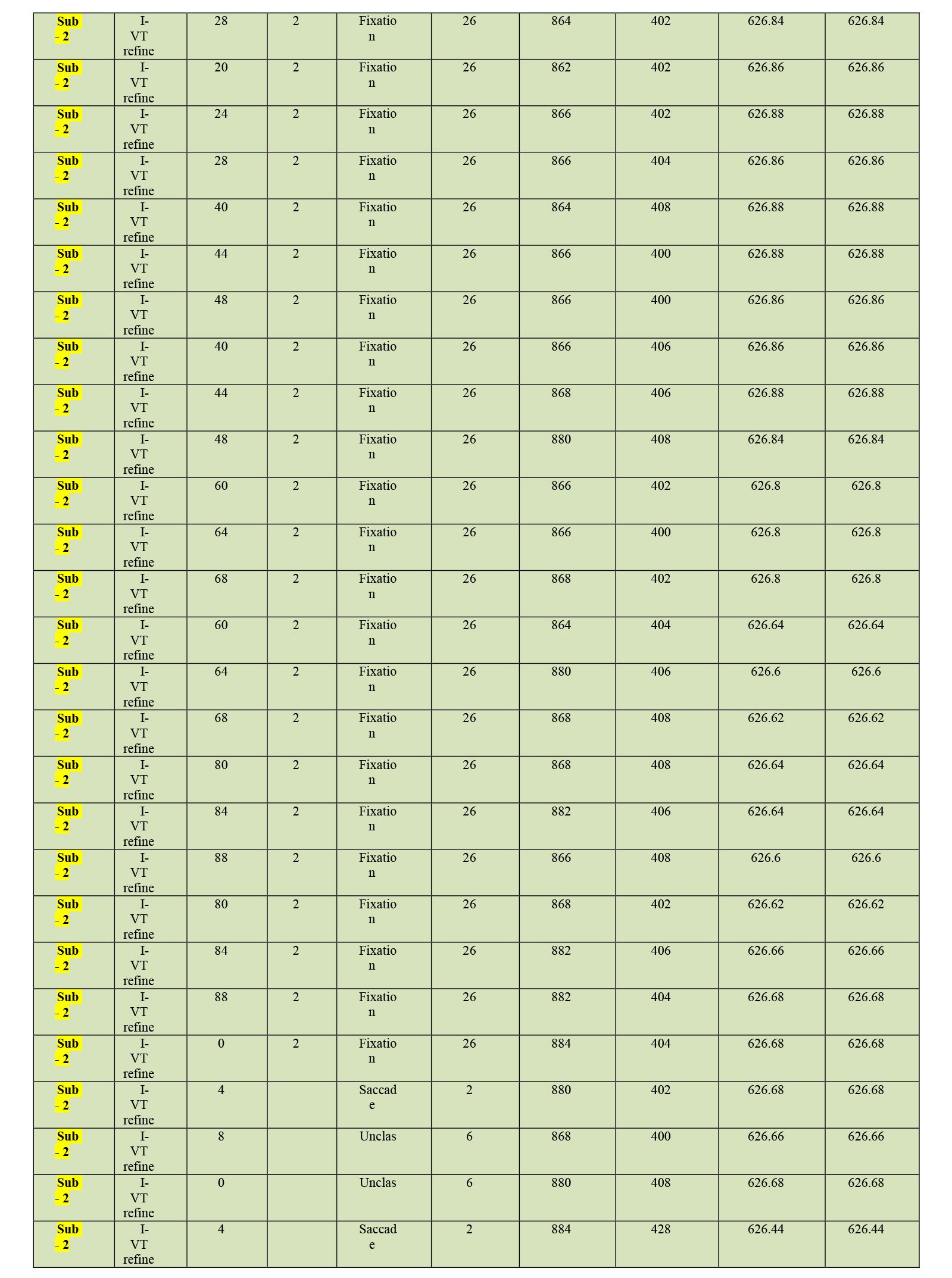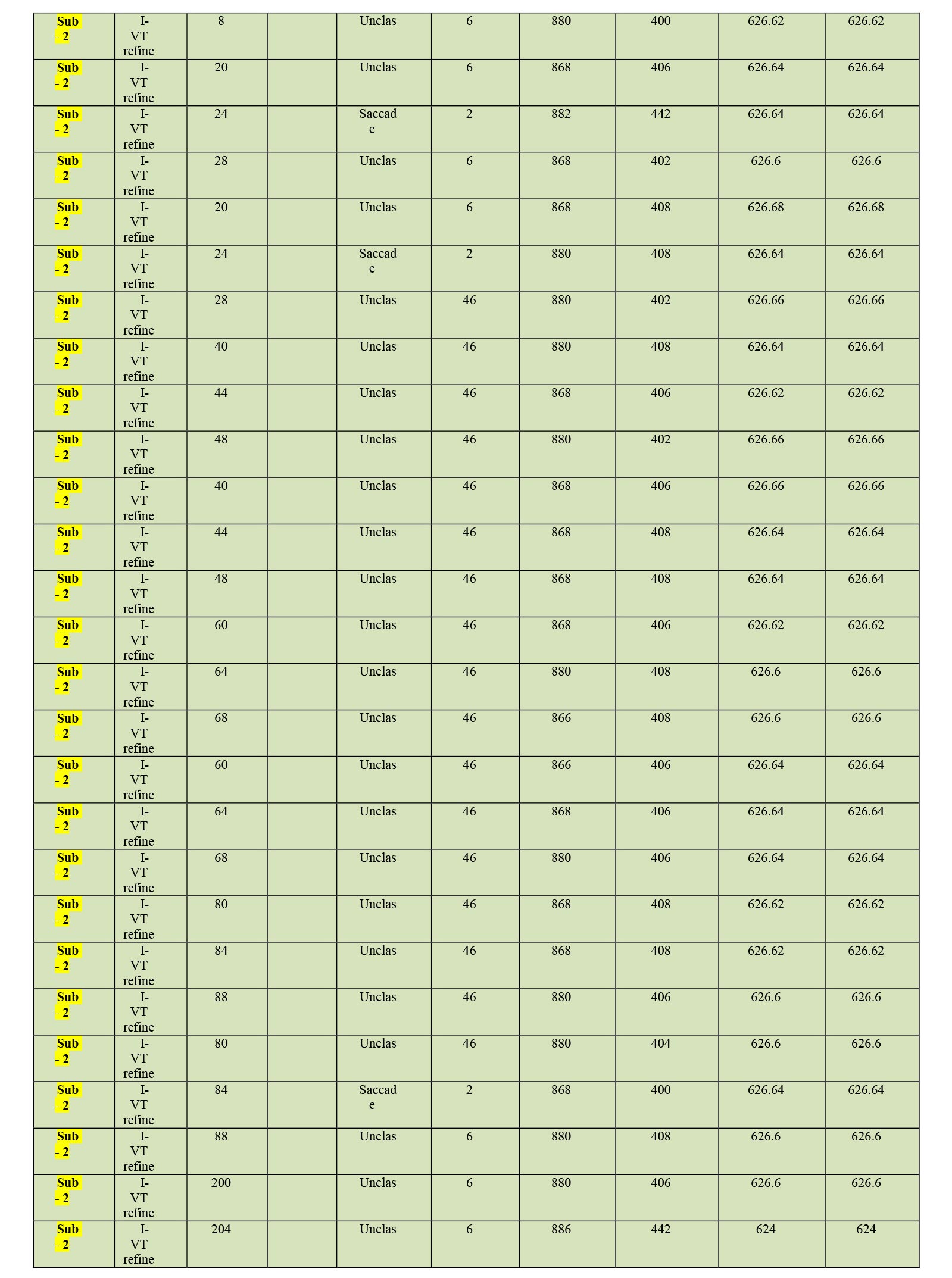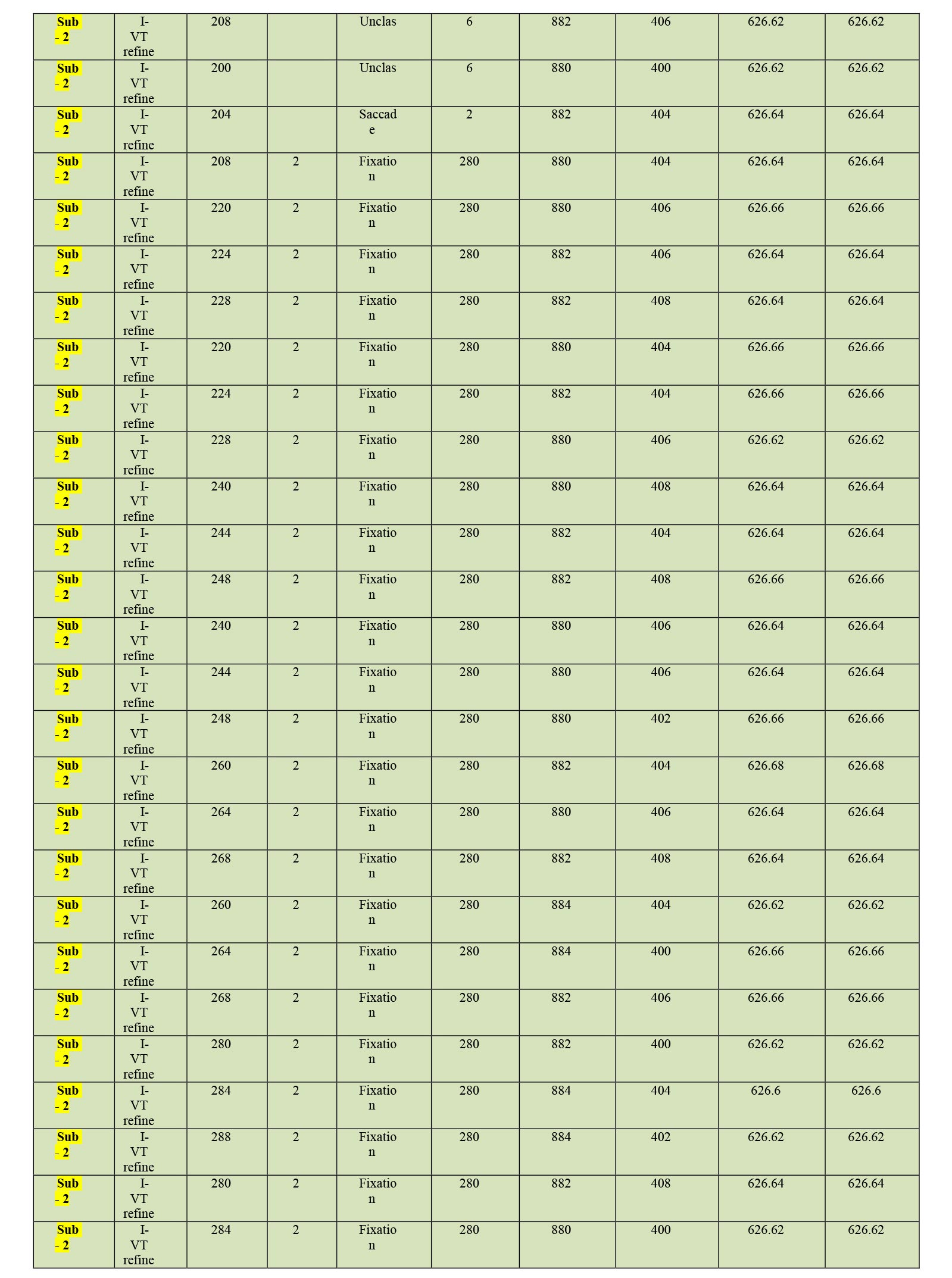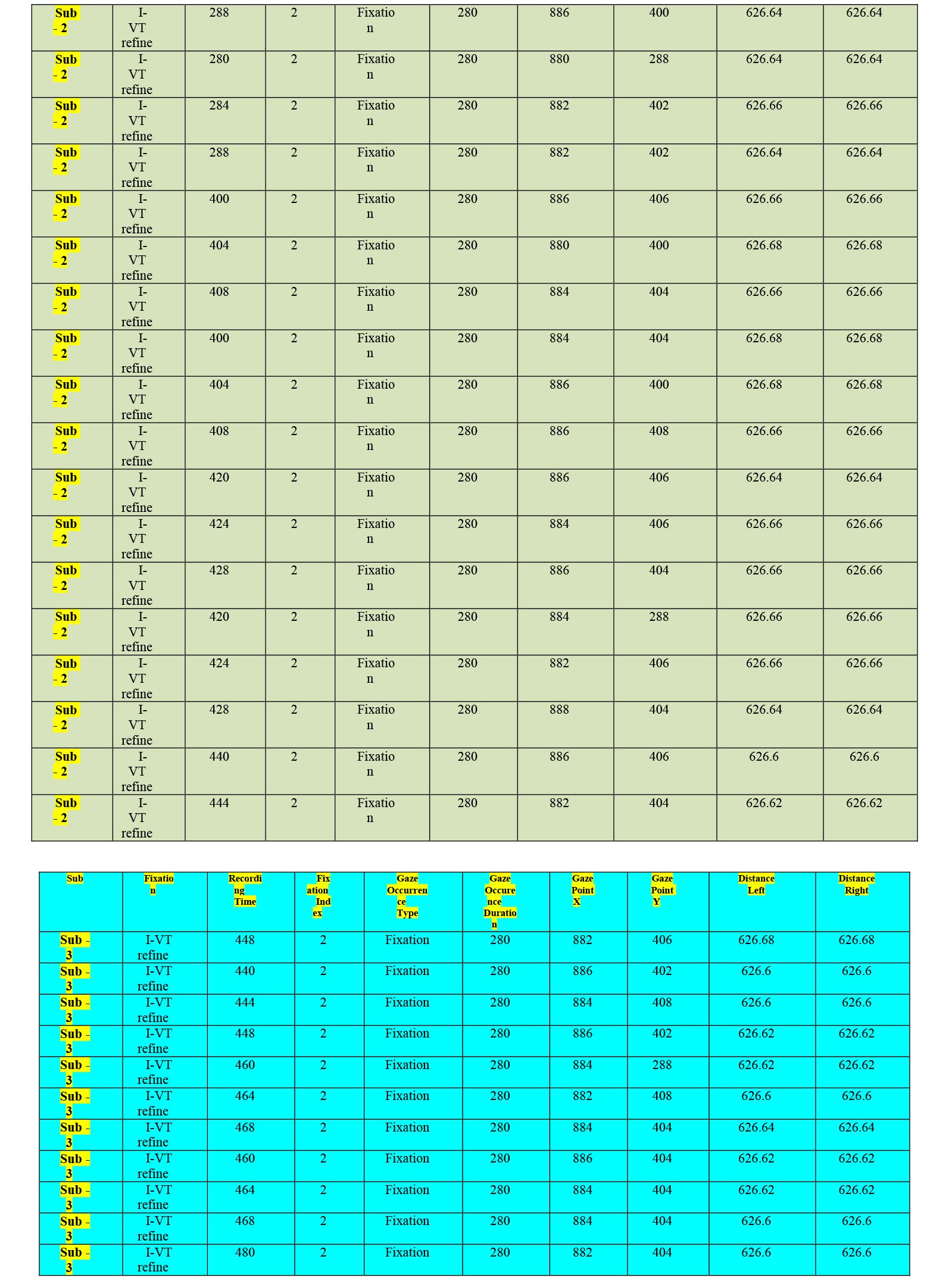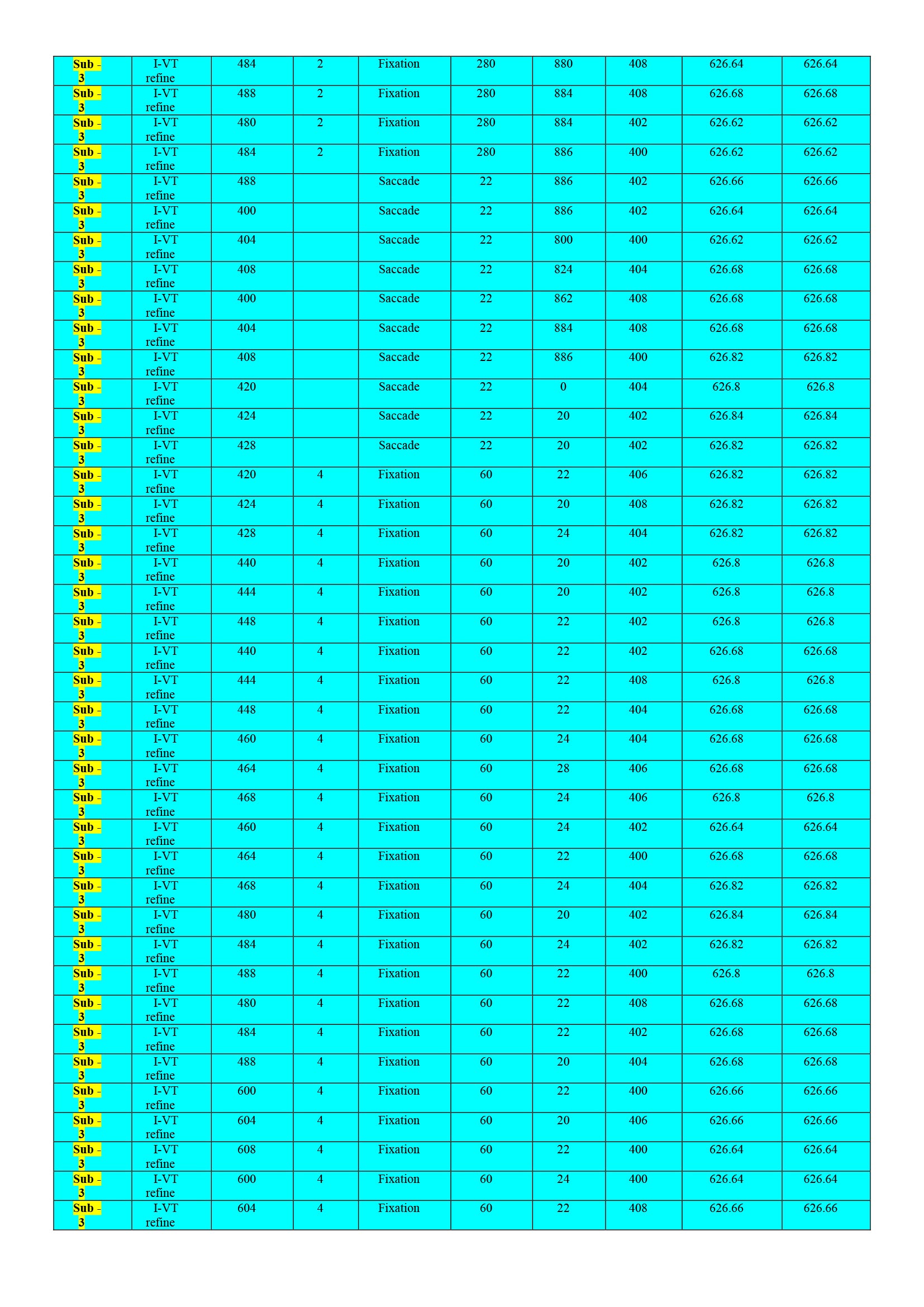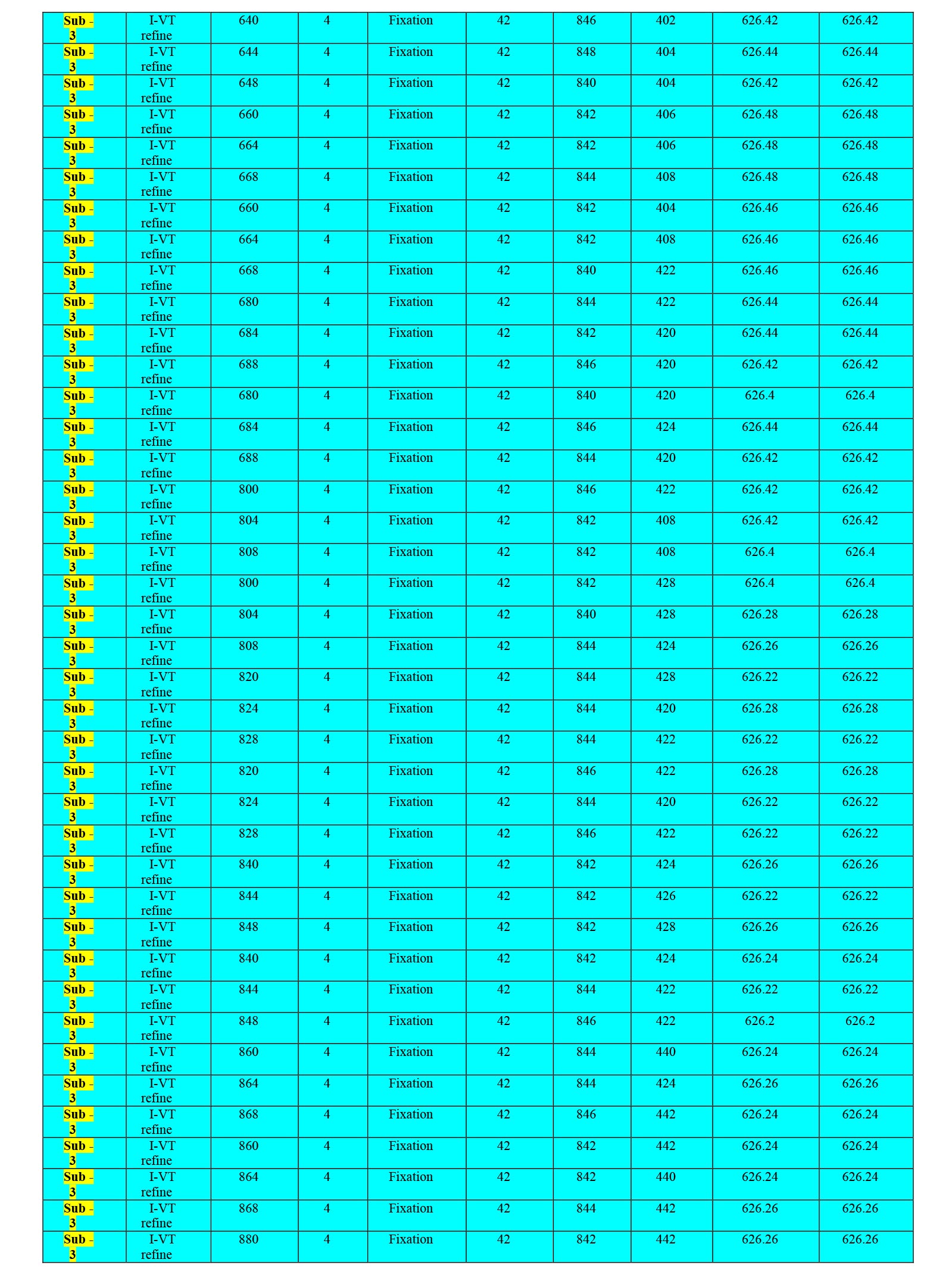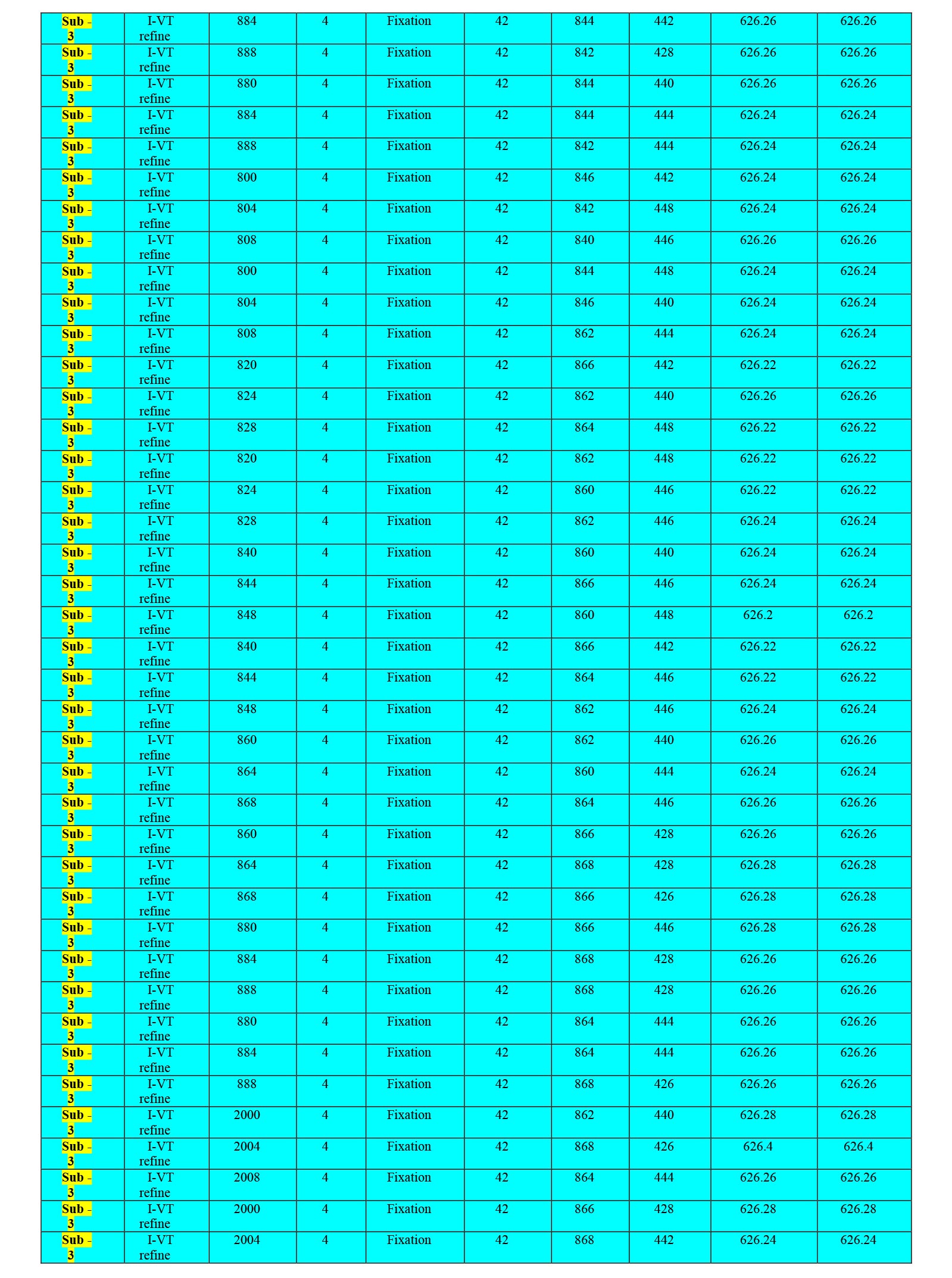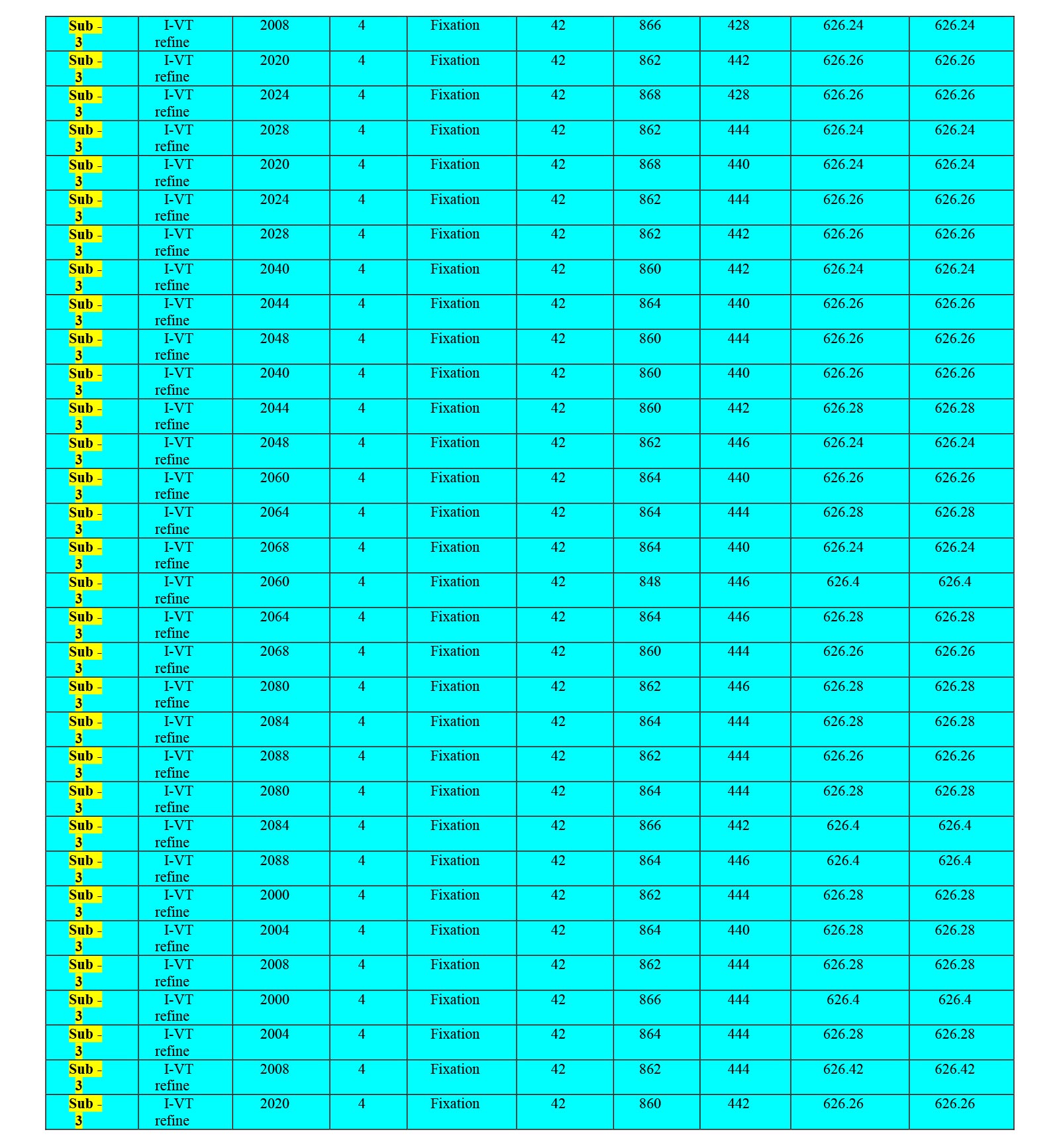Subscribe now to get notified about IU Jharkhand journal updates!
Complex Dis-Ordered Embroidery in Decisional Algorithms
Abstract :
Paper presents an inter – disciplinary approach towards human decision making mosaic via optometric injections. Study incorporates entrepreneurial brain practices as wedded to neuro-sciences. If disordered embroidery VUCA (Vulnerability, Uncertainty, Complexity, and Ambiguity) has given foundation to disordered embroidery BANI (Brittle, Anxious, Non-linear, and Incomprehensible), disordered embroidery RUPT (Rapid, Unpredictable, Paradoxical, and Tangled) and disordered embroidery TUNA (Turbulent, Uncertain, Novel and Ambiguous), it is tractable that time is fitting for anatomical ‘steal a look’ into entrepreneurial choice behaviour. Study opines that inter-sections between Biology and Management are far-reaching and hold immense potential for advancing managerial practices. By recognizing and integrating biological underpinnings of human behaviour, decision making, leadership, and adaptability, managers can devise informed and effective strategies. As fields of Biology and management continue to evolve, interdisciplinary collaboration is essential to unlock full spectrum of cause-and-effect connections between these domains. Aim has been to decipher decision making via optometric estimates. Eye tracking methodology is adopted. Kowlers eye tracking model has been examined. Deductions are; eye movements in human decision behaviour making is moderately driven by stimulus properties that bias information uptake in favor of visually salient stimuli. Eye movements do (not) have causal effect on preference formation. However, through properties inherent to visual system, such as stimulus-driven attention, eye movements do lead to down-stream effects on human decision behaviour making.
Keywords :
Decision Making, Eye Movement, Kowler, Disordered Embroidery and Opto - ComplexitiesIntroduction
Human decision behaviour science is a multi-disciplinary field (primary amalgamation of Experimental Economics, Behavioural Economics and Decision Theory) with purpose of focus on processes, methods, and motivations behind human decision behaviour (Ridley; 2003). With amplified focal point on capacity to incarcerate, store and access data, human decision behaviour science is a critical tool in analyzing large quantities of information to divulge optimal choices (Ridley; 2003). While appreciably informed by cognitive and behavioural sciences, application of human decision behaviour science draws together qualitative and quantitative embroidery that provide insights into human decision behaviour making in business (Satpathy; 2003). Debate, ‘is entrepreneurial brain practices an Art or Science’, has juxtaposed 21st Century as versatile playfield in entrepreneurial (fluid) intelligence practices (Satpathy; 2003). Over decades, entrepreneurial brain (fluid) intelligence practices has metamorphosed ushering era of inter - disciplinary practices (complicated but significant in spite of fresh judgment tasks) with ‘human beings’, as ‘Vital Agents’ of behaviour (Ridley; 2003).
In terrain of content composition, two pivotal elements emerge as overriding: ‘Perplexity’ and ‘Burstiness’ (Satpathy; 2023 & Ridley; 2003). Perplexity, in quintessence, gauges convoluted nature of conceptual or speculative theme, while burstiness delves into proportional oscillation in decision structures (Satpathy; 2023 & Ridley; 2003). It is accepted phenomenon that individuals have a propensity to corral thoughts with sensitive burstiness, naturally intertwining protracted and complicated views with shorter, concise ones (‘fair-minded estimation of thoughts’). Tout Court; these lead to espouse unwavering embroidery, operational tools, procedures and multi - dimensional background (Satpathy; 2023 & Ridley; 2003). As final point, entrepreneurial brain practices are committed to neuro-sciences (Satpathy; 2023 & Ridley; 2003). If disordered embroidery VUCA (Vulnerability, Uncertainty, Complexity, and Ambiguity) has given underpinning to chaotic embroidery BANI (Brittle, Anxious, Non-linear, and Incomprehensible), disordered embroidery RUPT (Rapid, Unpredictable, Paradoxical, and Tangled) and disordered embroidery TUNA (Turbulent, Uncertain, Novel and Ambiguous), it is biddable that - time is fitting for anatomical ‘steal a look’ into entrepreneurial choice behaviour (Satpathy; 2023 & Ridley; 2003). Time is mature to ‘hold in your arms package’ of disordered embroidery Vulnerability, Uncertainty, Complexity, Ambiguity, Brittle, Anxious, Non-linear, Incomprehensible, Rapid, Unpredictable, Paradoxical, Tangled, Turbulent, Uncertain, Novel and Ambiguous with a positive lens that exhibits positivity, emotions, feelings, and gut impulse. Synchronized with forces of ‘disordered embroidery conditions’, there is a need to calculate varying technologies with tactical thinking (‘acknowledgement of confines of knowledge’). Acronyms may transfigure... but variation will be inflexible and constant! Ingenuity calls for introspection of eye (behaviour) with portrayal and (psycho) analysis of how eye works to portray understanding of natural basis of entrepreneurial preference behaviour (Collewijn, et. al.; 1992).
When referring to humans as ‘Tout Court,’ it suggests simplified or concise perceptive of human nature or characteristics (Collewijn, et. al.; 1992). However, it is of essence to note down that humans are complex beings with diverse traits, behaviours, and experiences (Collewijn, et. al.; 1992). Describing humans ‘Tout Court’ may fail to notice minutiae and individuality that exist within human inhabitants (Collewijn, et. al.; 1992). It is accurate to acknowledge comprehensive nature of humans and recognize that each person is unique, influenced by combination of biological, psychological, social, and cultural factors (Collewijn, et. al.; 1992). Humans are, ‘Tout Court’, complex, non-linear matrixes and interact dynamically while making human decision behaviours (Collewijn, et. al.; 1992). Tout Court; are (all) human beings rational? This discussion declares NO (Collewijn, et. al.; 1992). Neo-classical paradigm of bounded rationality is eroded and convinces human brain that it is somewhere it really is not (Collewijn, et. al.; 1992). Modern Neuromanagement assumes that human decision behaviour making involves rational maximization of expected utility (Collewijn, et. al.; 1992).
‘Evidential Decision Theory (EDT) states that, when ‘Cogent Driving Force’ is confronted with set of probable actions, one should select stroke with peak significance, that is, exploit which would be analytic of best outcome in prospect’ (Wikipedia) (Collewijn, et. al.; 1992). This framework is used in decision theory to guide decision making under uncertainty (Collewijn, et. al.; 1992). It focuses on making decisions based on available confirmation and probability associated with different outcomes (Collewijn,,et. al.; 1992). In EDT, decision is equipped with expected value of different actions, available evidence and probabilities assigned to different outcomes. It emphasizes importance of updating beliefs and probabilities based on new evidence and making decisions that maximize expected utility. EDT differs from other decision theories, in how it handles decision making where Agent's actions affect evidence available to them (Collewijn; 1992). EDT places prominence on evidence and probabilities associated with different outcomes, rather than solely focusing on causal relationships or functional form of decision algorithms. Overall, EDT provides framework for decision making that take into explanation available evidence and probabilities to make rational choices under improbability.
Decision making is deeply rooted in biological processes (Haselton & Buss; 2000). Realm of Biology and Management have been regarded as distinct disciplines, with little apparent overlap (Camerer; 2003). However, recent advancements in both fields have highlighted inter-connectedness of these seemingly disparate domains (Camerer; 2003). Management focuses on optimizing resources and guiding human efforts towards organizational goals. It, is primarily influenced by biological factors that shape human behaviour, decision making, and adaptability (Camerer; 2003). Interplay has garnered significant attention as researchers delve into intricate cause-and-effect connections driven by recognition that biological principles and processes underpin various aspects of management, influencing decision making, organizational behaviour, and strategic planning (Camerer; 2003). At core lies principle of cause and effect, where actions lead to reactions, shaping evolution and adaptation of organisms (Haselton & Buss; 2000). In same vein, managerial decisions and actions set off series of cascading effects within organization, influencing growth and outcomes (Haselton & Buss; 2000). Drawing inspiration from nature's blueprint, managers gain deeper understanding of impact choices have on organizational ecosystem (Haselton & Buss; 2000). Neuro-scientific researches reveal that human decisions are influenced by cognitive and emotional factors, driven by neural pathways and neuro-transmitter interactions (Haselton & Buss; 2000). Understanding these underpinnings aid managers in designing effective decision making frameworks that consider both rational analysis and emotional resonance (Haselton & Buss; 2000). In addition, insights from behavioural genetics suggest genetic basis for risk-taking behaviour, influencing willingness of individuals to embrace innovative strategies in management (Haselton & Buss; 2000).
In conclusion, intersection between Biology and Management are far-reaching and hold immense potential for advancing managerial practices (Damasio,; 1994). By recognizing and integrating biological underpinnings of human behaviour, decision making, leadership, and adaptability, managers devise informed and effective strategies (Damasio,; 1994). As fields of Biology and Management continue to evolve, interdisciplinary collaboration between Researchers, Practitioners, and Policymakers will be essential to unlock full spectrum of cause-and-effect connections between these domains (Damasio,; 1994). Ultimately, deeper understanding of biological foundations of management leads to enhanced organizational performance, subject well-being and sustainable success. This is presumed as if humans are equipped with unlimited knowledge, time and information processing power. Psychological research has eroded foundation of mainstream Neuro-management mandating fresh approach than adaptation of existing theory. First, tenet is that human decision behaviour is not as independent as anticipated. Second, tenet regards basic level of individual human decision behaviour replaces bounded rationality. There is need to investigate disordered embroidery VUCA - BANI - TUNA and RUPT (VBTR) based choice making seismicity within clarifying blueprints and probabilistic functional parameters. Promising field of neuromanagement appears to proffer conjectures and practices continuum.
Opto Neuro-Determinism
It is intriguing to think how one takes decision and behave (Satpathy; 2023). Behavioural scientists study how cognitive actions are shaped, through nature (genes) or nurture (environment). Model of opto neuro-determinism has answers Satpathy; 2023). Opto neuro-determinism theorizes that genes and wiring of brain plays role in shaping personalities, cognition and behaviour Satpathy; 2023). Throughout lifespan, brain goes through several stages of development; from infancy to adulthood Satpathy; 2023). Wiring of brain depends upon things that individual consumes throughout developmental years (Satpathy; 2023). Shape or wiring of brain strongly depends upon kind of physical environment, hormones, relationship between genes and working of brain (Satpathy; 2023). Neurobiology includes brain, spinal cord, and nerves throughout body. It examines how nerve cells, called neurons, communicate with each other and how they work together to control various bodily functions. Different regions of brain are responsible for specific functions. In context of opto neuro-determinism, neurobiology helps understand how brain's structure and activities influence behaviour. Connections between neurons, known as synapses, play crucial role in transmitting information. Changes in connections, driven by genetics and experiences, contribute to development of behaviours and cognitive processes. Neurobiology encompasses concept of neuroplasticity, which refers to brain's ability to adapt and change over time. Experiences, interactions, and learning reshape neural pathways and modify brain structures. Opto neuro-determinism is a philosophical concept that suggests all human thoughts, behaviours, and actions are solely determined by structure and functioning of brain. It proposes that physical processes occurring in nervous system, including firing of neurons and release of neuro-transmitters, predetermine thoughts and actions. This perspective implies that free will and personal agency may be limited or even nonexistent, as action is believed to be determined by biological processes in brains. It is important to note that opto neuro-determinism is a debated topic among Philosophers, Neuroscientists, and Psychologists, and there are alternative viewpoints that argue for existence of free will and influence of other factors on human behaviour. This phenomenon highlights dynamic nature of brain and how it continuously evolves based on genetic and environmental influences (Epelboim, et; 1995)
As one explores deeper into concept of opto neuro-determinism, one observes confluence of genetics, neurobiology and interplay of nature vs. nurture. Through study and exploration of opto neuro-determinism, we unearth underpinnings of personality traits, roots of human decision behaviour making and origins of complex mental processes. It sheds radiance on phenomenon of neuroplasticity and influence of genes in cognitive and behavioural process. Although genes play important role in determining personalities, cognition and behaviour, environmental influences play major role in rewiring brain and transform individual while they are growing up. This phenomenon is called neuroplasticity (Epelboim, et; 1995). By understanding how brains are wired and what influences its shape and form, we gain insights on human decision behaviour making process, choices and preferences. Opto neuro-determinism highlights importance of environmental influence in shaping brain and influence on thought processes. Human brain is a complex and intricate organ that consists of various regions, each with distinct functions. These regions play pivotal role in controlling behaviour and shaping interactions with environment. Understanding the functions of these brain areas provides insight into complexity of human behaviour (Epelboim, J., et.al..; 1995, 1997).
Frontal lobes are involved in higher cognitive functions. They play crucial role in human decision behaviour making, problem solving and planning. This region helps organize thoughts, make judgments, and anticipate consequences of actions. Additionally, frontal lobes are essential for social behaviour, emotional regulation and empathy. Temporal lobes are associated with memory, language comprehension and auditory processing. They enable to recognize faces, understand spoken and written language and retrieve stored memories. Temporal lobes are vital for forming and consolidating long-term memories and contribute to ability to communicate effectively. Parietal lobes are responsible for sensory perception and spatial awareness. They integrate sensory information from various parts of body, allowing perceiving surroundings accurately. Parietal lobes enable to coordinate movements, understand body's position in space and process tactile sensations. Occipital lobes are primarily responsible for processing visual information. They receive and interpret signals from eyes, allowing to perceive colours, shapes, and motion. The occipital lobes enable to recognize and interpret visual stimuli, forming foundation of visual perception. Brainstem is located at base of the brain and serves as critical control center for essential bodily functions. It regulates automatic processes such as heart rate, breathing, and digestion. Additionally, brainstem plays role in maintaining consciousness and alertness. Its functions are vital for survival and ensure body's internal balance.
These distinct brain regions do not operate in isolation; they form complex network of communication and coordination. Neural pathways connect these areas, enabling information to flow seamlessly between them. This interconnectedness allows different brain regions to collaborate in orchestrating behaviours, thoughts, and emotions. While each brain region has specialized functions, it is significant to emphasize that behaviour is not solely determined by a single area. Instead, behaviour arises from intricate interplay and integration of signals from multiple brain regions. Tout Court, brain is remarkably adaptable and capable of rewiring itself in response to experiences and learning. This phenomenon, known as neuroplasticity, enables brain to adapt to changing circumstances and refine its functions over time (Epelboim, J., et.al..; 1995, 1997). In conclusion, human brain comprises distinct regions that collectively contribute to behaviour and cognitive abilities. From human decision behaviour making in frontal lobes to visual perception in occipital lobes, each region plays a unique part in shaping interactions with world. Complex interconnections between these brain areas underscore intricate nature of human behaviour and provide foundation for further exploration and understanding.
In study of opto neuro-determinism, two key fields come into focus: Genetics and Neurobiology (Johansson, et. al.; 2001). These fields shed light on how brain's structure and functions influence behaviour and shape who we are (Johansson, et. al.; 2001). Genetics is study of genes, which are like tiny units of instruction found in cells (Johansson, et. al.; 2001). These instructions, made up of DNA, carry information needed for bodies to develop, function, and reproduce (Johansson, et. al.; 2001). They determine various traits, such as eye colour, height, and certain aspects of personality (Johansson, et. al.; 2001). In context of opto neuro-determinism, genetics plays significant role (Johansson, et. al.; 2001). Genes contribute to construction of brain - control center of body (Johansson, et. al.; 2001). They guide development of neural pathways, connections between brain cells that allow information to travel (Johansson, et. al.; 2001). These pathways are like highways that carry messages throughout brain, influencing how we think, feel, and act (Johansson, et. al.; 2001). Genes influence production of neurotransmitters, which are chemicals that transmit signals between brain cells (Johansson, et. al.; 2001). These chemicals affect mood, emotions, and behaviours (Johansson, et. al.; 2001). Variations in genetic makeup can lead to differences in neurotransmitter levels and functioning, contributing to unique behavioural tendencies (Johansson, et. al.; 2001).
Genetics and neurobiology intersect within framework of opto neuro-determinism (Johansson, et. al.; 2001). Genetic makeup influences wiring of brain and production of essential chemicals that affect behaviour (Johansson, et. al.; 2001). Neurobiology explores mechanisms underlying these influences, delving into intricate workings of neural circuits and communication (Johansson, et. al.; 2001). Opto neuro-determinism suggests that brain's Biology is a significant factor in shaping behaviour (Johansson, et. al.; 2001). While genetics and neurobiology provide valuable insights, it is imperative to recognize that they interact with environmental factors, experiences, and individual choices (Johansson, et. al.; 2001). Interplay between these elements creates nuanced picture of human behaviour and underscores intricate balance between nature and nurture (Johansson, et. al.; 2001). Genetics and neurobiology offer essential perspectives within realm of opto neuro-determinism (Johansson, et. al.; 2001). Genes contribute to development of brain and influence neurotransmitter activity, while neurobiology reveals brain's complex operations and its capacity for change (Johansson, et. al.; 2001). This multidimensional approach enhances understanding of how brain's Biology influences behaviour and underscores the intricate interplay between genetic makeup, neural processes, and environments one navigates (Johansson, et. al.; 2001).
In exploration of opto neuro-determinism, a concept that examines how brain's Biology influences behaviour, spotlight falls on neuroplasticity (Johansson, et. al.; 2001). Neuroplasticity refers to brain's remarkable ability to adapt, change, and reorganize itself throughout in response to experiences, learning, and environmental influences (Johansson, et. al.; 2001). At core of neuroplasticity lies recognition that brain is not a static and unchanging entity, but dynamic and flexible organ (Johansson, et. al.; 2001). This concept challenges notion that brain's structure and functions are predetermined, highlighting profound impact of experiences on shaping who we are (Johansson, et. al.; 2001). Neuroplasticity manifests in two primary forms: structural plasticity and functional plasticity (Johansson, et. al.; 2001). Structural plasticity involves physical changes in brain's neural pathways and connections (Johansson, et. al.; 2001). It encompasses processes such as ‘Dendrite Branching’, where nerve cells extend new branches to establish connections with other neurons (Johansson, et. al.; 2001). Additionally, new synapses can form, while others weaken or disappear, altering communication network within brain (Johansson, et. al.; 2001).
Functional plasticity, relates to brain's ability in direction of redistributing functions across different areas (Johansson, et. al.; 2001). In cases of injury or sensory deprivation, brain can reassign specific tasks to other regions to compensate for loss of function (Johansson, et. al.; 2001). This adaptability allows individuals to regain cognitive and motor abilities, emphasizing brain's flexibility in response to challenges (Johansson, et. al.; 2001). While opto neuro-determinism suggests link between brain Biology and behaviour, neuroplasticity introduces critical layer of complexity (Johansson, et. al.; 2001). It signifies that even though genetic and biological factors influence brain's initial structure, experiences and interactions with environment continue to mold and reshape it (Johansson, et. al.; 2001). In context of opto neuro-determinism, neuroplasticity challenges notion of rigid determinism (Johansson, et. al.; 2001). It suggests that while brain's Biology may set certain predispositions, it is not an unchangeable script that dictates behaviour (Johansson, et. al.; 2001). Instead, brain retains remarkable degree of malleability, allowing adapting, learning, and refining actions over time (Johansson, et. al.; 2001).
The concept of opto neuro-determinism, which suggests that brain's Biology influences behaviour, gives rise to thought-provoking moral dilemmas that challenge traditional notions of responsibility and personal choice (Cohen, et.al.;2007). At heart of this dilemma lies question of free will (Cohen, et.al.2007). If actions are significantly shaped by brain's wiring, do we truly possess the capacity to make independent choices? This raises concerns about assigning blame or credit for actions when brain's Biology may exert substantial influence (Cohen, et.al.2007). It challenges fundamental understanding of accountability and ability to guide conscious behaviour (Cohen, et.al.2007). If brain's structure contributes to criminal behaviour, should one reconsider punitive nature of punishment and explore rehabilitative approaches? Conversely, recognition of opto neuro-determinism offers opportunity for greater empathy and understanding. It prompts to view individuals not solely as architects of actions but products of intricate biological and environmental factors. This shift in perspective can influence attitudes towards conditions influenced by neurobiology, fostering compassionate and supportive approach. In navigating these moral dilemmas, we must wallop a balance between recognizing influence of opto neuro-determinism while preserving concepts of accountability and personal agency. Exploration of these ethical complexities encourages redefining traditional embroidery of responsibility and considering nuanced understanding of human behaviour and underlying causes.
In conclusion, concept of opto neuro-determinism, which posits that Biology, particularly genes and brain wiring, plays significant role in shaping behaviour, opens door to profound insights and inquiries (Gersch, et. al; 1991). As we delve into intricate interplay between nature and nurture, genetics and neurobiology, and dynamic phenomenon of neuroplasticity, we uncover complex web of influences that contribute to tapestry of human behaviour (Gersch, et. al.; 1991). The nature vs. nurture debate underscores that both genetic predispositions and environmental experiences work in tandem to shape cognitive processes and personalities (Gersch, et. al; 1991). This collaborative dance between nature and nurture paints holistic picture of human development, emphasizing importance of both genetic blueprints and life experiences (Gersch, et. al.; 1991). Examining distinct brain regions reveals specialized division of labor within brain, each area contributing to specific functions and behaviours (Gersch, et. al; 1991). Yet, interconnectedness of these regions highlights intricate orchestration required for thoughts, emotions, and actions to harmonize (Gersch, et. al.; 1991). Genetics and neurobiology stand as pillars in edifice of opto neuro-determinism, providing invaluable insights into fundamental mechanisms underlying behaviour (Gersch, et. al.; 1991). While genetic makeup forms foundation, neurobiology unveils dynamic operations of brain, including its adaptability through neuroplasticity (Gersch, et. al; 1991). Dynamic interaction broadens understanding of how genetics and experiences interlace, influencing rich tapestry of human behaviour (Gersch, et. al.; 1991).
Evaluation of Literature
Eye tracking has been extensively studied in framework of decision making, with growing body of research investigating relationship between eye movements and various aspects of decision making (Kowler, et. al; 1991). Numerous studies have explored role of eye movements in decision making across different domains including consumer behaviour, finance, sports, medicine, and more (Kowler, et. al; 1991). Eye tracking has been used to investigate how to process information, attend to relevant cues, and make decisions based on these cues (Kowler, et. al; 1991). Eye tracking has been used to understand how decision making differs across individuals with varying levels of expertise, cognitive abilities, and decision making styles (Kowler, et. al; 1991). Overall, significant amount of work has been done on eye tracking in decision making (Kowler, et. al; 1991). Despite research amassed from laboratory settings, almost all decisions involve acquiring visual information (Kowler, and Rubinstein, et.al.; 1977, 1979, 1980, 1981). Still, decision making is a special task where data is valued differently in each case (Kowler, and Rubinstein, et.al.; 1977, 1979, 1980, 1981). They use Eye Tracking to trace a cognitive process: gaze behaviour during decision making in a natural environment (Kowler, and Rubinstein, et.al.; 1977, 1979, 1980, 1981). Traditionally, metrics used to trace decision making processes are challenging to use in natural environments that contain options and unstructured information (Kowler, and Rubinstein, et.al.; 1977, 1979, 1980, 1981). First, decision making literature has incorporated eye movement recordings previously (Kowler, and Rubinstein, et.al.; 1977, 1979, 1980, 1981). These focus on how eye movements unfold throughout decision process, specifically attentional shifts toward chosen object (Kowler, and Rubinstein, et.al.; 1977, 1979, 1980, 1981). Second, while above mentioned research taps into decision making process, it must focus on how information is acquired and integrated (Kowler, and Rubinstein, et.al.; 1977, 1979, 1980, 1981). In addition, it aims to uncover timeline of gaze behaviour in decision making task and devise a model of decision making process based on this information (Kowler, and Rubinstein, et.al.; 1977, 1979, 1980, 1981).
Based on above evaluation, this paper combines eye-tracking research with attempts (perception of challenges, how ubiquitous they are across disciplines and being addressed plus areas for expansion) to trace decision making process (Kowler, and Rubinstein, et.al.; 1977, 1979, 1980, 1981). As will be shown below, introspection may lead one to believe that information gathering on comparison websites is a reasonably well ordered and organised process (Kowler and Anderson et.al.; 1985). However, facts from experiment point to opposite conclusion (Kowler and Anderson et.al.; 1985). That is, it is challenging to determine exactly how tactics are utilized over time and what information is gained since vast quantities of dense eye fixation data often make it impossible to tell whether information acquisition is attribute-based or product-based (Kowler and Anderson et.al.; 1985). Therefore, given rapid attribute and product based information acquisition processes during decision making as well as switching between these processes are fundamentally unobservable, main goal of research is to develop model-based approach that makes it easier to draw conclusions about them (Kowler and Anderson et.al.; 1985). Latent cognitive states call information acquisition processes guide eyes as they scan display for information (Shi & Wedel, 2013).
Clinical decision making has recently piqued the attention of scholars in field of healthcare (Sahoo, K. and Satpathy et. al.; 2021 and Sahoo and Satpathy et.al.2021). Mapping literature on eye-tracking technique is helpful in bringing together all research on how decision makers make choices and findings may add to clinical training (Sahoo, K. and Satpathy et. al.; 2021 and Sahoo and Satpathy et.al.2021). A wide variety of research was observed to provide comprehensive knowledge of many facets of cue processing and mistakes in clinical decision making, and findings are given in descriptive manner (Sahoo, K. and Satpathy et. al.; 2021 and Sahoo and Satpathy et.al.;2021). Evaluation demonstrates need for research into cue processing and clinical judgment (Sahoo, K. and Satpathy et. al.; 2021 and Sahoo and Satpathy et.al.2021). One method for conducting impartial assessment of visual-cognitive components of decision making is eye tracking (Sahoo, K. and Satpathy et. al.; 2021 and Sahoo and Satpathy et.al.2021). With aid of human-computer interaction technique known as eye tracking, researchers can track eye movements of healthcare professionals (Sahoo, K. and Satpathy et. al.; 2021 and Sahoo and Satpathy et.al.2021). At same time, assigned tasks determine where they are looking (Sahoo, K. and Satpathy et. al.; 2021 and Sahoo and Satpathy et.al.2021). Recently, eye-tracking methods have been utilized as research tool for applications in healthcare investigations. Several reviews have already used eye tracking to evaluate skills of healthcare professionals and train them (Al-moteri et al., 2017).
For complicated judgments, when benefits and drawbacks of several alternatives are about equal but difficult to assess, there is strong intuition of ambivalence in cognition. Information search has been studied using experimental methodology that includes giving participants ambiguous questions and tracking attentional dynamics concerning data pertinent to each choice across several Areas of Interest (AOIs) (Sahoo, K. and Satpathy et. al.; 2021 and Sahoo and Satpathy et.al.;2021). Two dynamic models were created to characterize eye-tracking curves, one for each reaction individually (Sahoo, K. and Satpathy et. al.; 2021 and Sahoo and Satpathy et.al.2021). Models included Drift Mechanism towards different possibilities as in conventional Drift-Diffusion Theory (Sahoo, K. and Satpathy et. al.; 2021 and Sahoo and Satpathy et.al.2021). Additionally, they included internal oscillation mechanism that interfered with drift process and prevented dynamics from eventually stabilizing (Sahoo, K. and Satpathy et. al.; 2021 and Sahoo and Satpathy et.al. 2021). Breadth of assumed drift mechanisms differed between two models (Sahoo, K. and Satpathy et. al.; 2021 and Sahoo and Satpathy et.al.2021). Simplified model, which covered drifts from uncertainty state to one of two certainty levels, showed support. Additionally, model parameters could be tangentially connected to ultimate choice, adding to understanding of how eye-tracking structure influences choices (particularly gaze cascade effect) (Newell et al., 2022).
Some researchers have examined model predictions for underlying cognitive processes, which have been subject of models that have been put forward (Sahoo, K. and Satpathy et. al.; 2021 and Sahoo and Satpathy et.al.2021). Three prominent methods include connectionist methods like parallel constraint satisfaction (PCS) model, simple serial heuristic methods like the adaptive toolbox, and evidence accumulation methods like decision field theory (DFT) (Sahoo, K. and Satpathy et. al.; 2021 and Sahoo and Satpathy et.al.;2021). Two investigations that used pupil dilation and attentiveness measurements looked into theories developed from these models in decisions between two gambles with two possible outcomes (Sahoo, K. and Satpathy et. al.; 2021 and Sahoo and Satpathy et.al.;2021). This demonstrates that attention changes towards subsequently preferred bet after around two-thirds of the decision making process, showing a gaze-cascade effect, and attention to an outcome grows with its likelihood and value (Sahoo, K. and Satpathy et. al.; 2021 and Sahoo and Satpathy et.al.;2021). Overall, findings are in favor of several features of automated integration models for riskier options like DFT and PCS. However, they still need to take into consideration whole pattern of findings in existing definition (Fiedler and Glöckner, 2012). Many times, sensory data is insufficient to determine correctly a stimulus's nature, and judgments are made in face of ambiguity (Kowler, et. al; 1991). Current research investigated several oculomotor parameters' potential sensitivity to momentary uncertainty levels during perceptual decision making (Kowler, et. al; 1991). Pupil diameter provided detailed and dynamic information regarding the timing of perceptual choice making than other measurements, which tended to shift linearly with decision confidence (Kowler, et. al; 1991). Surprisingly few have sought to hone in on quantitative measures of choice uncertainty, despite prevalence and significance of perceptual decision making as well as potential effects of uncertainty on task performance (Kowler, et. al; 1991).
The current research investigates whether various eye-tracking-based metrics may be responsive to various degrees of uncertainty during a perceptual judgment task (Spivey, et. al.; 2002). Sensory, perceptual, cognitive, and behavioural processes involved in perceptual decision making are described in several theories (Spivey, et. al.; 2002). Second, perceptual difficulty or doubt is noted, motivating and directing attention to obtaining information (Spivey, et. al.; 2002). Some evidence supports the idea that the perceptual decision making process directs and engages visual attention to gather information that is important to choice (Spivey, et. al.; 2002). Second, it seems that these visual search procedures are dependent on unpredictable circumstances, which should have dependable impact on oculomotor activity when information about stimulus is obtained (Spivey, et. al.; 2002). These theories frequently emphasize neural mechanisms underlying various stages of perceptual decision process, using tools like functional magnetic resonance imaging, it's possible that these tools won't be feasible to use in practical settings where goal is to track perceptual decision uncertainty while performing tasks (Spivey, et. al.;2002). By comparing variations in activity in brain areas related to faces and houses, Scientists suggested that this brain region is involved in perceptual judgments (Spivey, et. al.; 2002).
Compared to adults, adolescents were more likely to make conservative, loss-minimizing choices consistent with economic models. Eye-tracking data showed that prior to decisions, adolescents acquired more information in a thorough manner; that is, they engaged in analytic processing strategy indicative of trade-offs between decision variables. In contrast, young adults' decisions were more consistent with heuristics that simplified the decision problem, at the expense of analytic precision (Kwak et al., 2015). Simulations and games bring possibility to research complex processes of managerial decision making. Many authors recommend use of a combination of concurrent think-aloud (CTA) or retrospective think-aloud (RTA) with eye tracking to investigate cognitive processes such as decision making. Nevertheless, previous studies have little or no considerations of possible deferential impact of both think-aloud methods on data provided by eye tracking. Results empirically prove that CTA significantly distorts data provided by eye tracking, whereas data gathered when RTA is used, provide independent pieces of evidence about participants' behaviour. These findings suggest that RTA is more suitable for combined use with eye-tracking for purpose the research of decision making (Ladislav, 2020).
Opthalmic Embroidery
Eye movements are central measure of human decision behaviour (Kowler, et. al; 1991). Exploration on human decision behaviour making has extended from human decision behaviourist loom to cognitive approach that focuses on human decision behaviour processes and ensues prior to response (Sahoo, K. and Satpathy et. al.; 2021 and Kowler, et. al; 1991). In neural computational simulations, human decision behaviour during behaviour task is represented by node of neural activity (Kowler, et. al; 1991). Human decision behaviour related neural activity has components of intensification of activity and human decision behaviour inception for neural activity to overcome human decision behaviour to be completed (Kowler, et. al; 1991). A way to investigate computational human decision behaviour making is to scan positioning of human decision behaviour leading to judgment point (Kowler, et. al; 1991).
Eye movements are indissolubly linked to optical consideration, as both are prime tools for choosing stimulating shares of chromatic prospects for enriched perceptual and rational processing (Kowler, et. al; 1991). Investigating eye movements is expedient in providing evidence of orientation of human decision behaviour replicating computational human decision behaviour during human decision behaviour formation (Kowler, et. al; 1991). Role of eye movements, intentional or reflex, help in gaining, possessing and tracing visual inducements, during human decision behaviour formation is not entirely clear (Kowler, et. al; 1991). Current proof suggests that orientation of eye movement itself may not be an essential constituent (Kowler, et. al; 1991). Rather, it can be because of intensification in contact to incitement as an influential factor in human decision behaviour formation (Kowler, et. al; 1991).
Neuro - opthalmics seeks to ground opthalmics theory in detailed neural mechanisms that are expressed mathematically and make neuro predictions (Kowler, et. al; 1991). Neuro - opthalmics exploits knowledge about eye mechanisms to inform opthalmics theory (Kowler, et. al; 1991). It opens ‘black box’ of eye, much as organizational opthalmics opened up the theory of the organisation (Kowler, et. al; 1991). The key insight for opthalmics is that eye is composed of multiple systems that interact (Kowler, et. al; 1991). Controlled systems (‘executive function’) interrupt automatic ones (Kowler, et. al; 1991). Eye evidence complicates standard assumptions about basic preference, to include homeostasis in addition to other kinds of state-dependence, and shows emotional activation in ambiguous choice and strategic interaction (Kowler, et. al; 1991). Neuro - opthalmics has further bridged disparate fields of opthalmics and psychology (Kowler, et. al; 1991). Such convergence is almost exclusively attributable to changes within opthalmics (Kowler, et. al; 1991). Neuro - opthalmics has inspired more change within opthalmics than within psychology because important findings in Neuro - opthalmics have posed more of a challenge to standard opthalmics perspective (Kowler, et. al; 1991). Neuro - opthalmics has challenged standard opthalmics assumption that human decision behaviour making is a unitary process-a simple matter of integrated and coherent utility maximization symptomatic of instead that it is driven by interaction between automatic and controlled processes (Kowler, et. al; 1991). Despite substantial advances, question of how we make human decision behaviours and judgments continues to pose important challenges for scientific research (Kowler, et. al; 1991). Historically, different disciplines have approached this problem using different techniques and assumptions, with few unifying efforts made (Kowler, et. al; 1991).
Neuro - opthalmics has emerged as inter-disciplinary effort to bridge this gap (Kowler, et. al; 1991). Research in Neuroscience and Psychology investigate neural bases of human decision behaviour predictability and value, central parameters in opthalmics theory of expected utility (Kowler, et. al; 1991). Opthalmics, in turn, is being increasingly influenced by multiple-systems approach to human decision behaviour making, perspective strongly rooted in Psychology and Neuroscience (Kowler, et. al; 1991). The integration of these disparate theoretical approaches and methodologies offers exciting potential for construction of accurate models of human decision behaviour making (Kowler, et. al; 1991). Goal is a geometric theory of how eye implements human decision behaviours tied to behaviour (Kowler, et. al; 1991). This is likely to show human decision behaviours for which rational-choice theory (strategy individuals use for cogent computation to formulate coherent choice and attain conclusion) is a good approximation (particularly for evolutionarily sculpted or highly learned choices), to provide deeper level of distinction among competing neuro alternatives, and provide empirical inspiration for opthalmics to incorporate nuanced ideas about endogeneity of preferences, individual difference, emotions, endogenous regulation of states, and so forth (Kowler, et. al; 1991).
How are organisational / individual and opthalmics human decision behaviours making processes carried out in eye? Do we interpret research findings when neurological results conflict with self-report? Knowing how eye is working explains little about what mind produces; what we think, what we believe and how we creates human decision behaviours (Vishwanath and Kowler; 2003, 2004).’ What are the general implications of neuro opthalmics? Neuroscience techniques permit to look inside eye while it experiences outcomes and crafts human decision behaviours (Vishwanathand Kowler; 2003, 2004). Neuro - opthalmics uses techniques to ask how entrepreneur (s) craft human decision behaviours and examine implications (Vishwanath and Kowler; 2003, 2004). Central argument of this submission is that Neuro - opthalmics, organisational psychology and neuroscience each benefit from taking account of insights that other disciplines offer in understanding human decision behaviour-making (Vishwanath and Kowler;2003, 2004).
This starts with premise that human decision behaviours (form of choices or effort allocation) can be traced back in structure of macro-scale eye activity, as measured with neuroimaging apparatus (Wu, Kwon and Kowler;2010). Typically, such responses involve regions in eye (mid-eye to prefrontal cortices, through parietal and basal ganglia structures), who’s precise function in terms of motivational processes depends upon context (specific task eye) (Wu, Kwon and Kowler; 2010). This context-dependency expresses itself through (induced) specific plasticity of these eye networks, in parallel to phasic and tonic changes in neuro-modulator activity (Wu, Kwon and Kowler; 2010). In turn, macro-scale reconfiguration of eye networks subtends learning and yield adaptive behaviour (Wu, Kwon and Kowler; 2010). In other words, it is likely that goal-directed behaviour emerges from interactions with purpose of shaping spatio-temporal embroidery of macro-scale eye networks (Wu, Kwon and Kowler; 2010). This means that understanding mechanics of motivational processes from multimodal observation of eye activity (electrophysiology, fMRI) and neuro measurements (explicit choices, reaction times, autonomic arousal signals, grip force) poses exciting challenge of quantitatively relating information processing to eye effective connectivity (Wu, Kwon and Kowler;2010).
Questions that will be answered in this course include how to choose in tough situations where stakes are high, and there are multiple conflicting objectives (Kowler, et. al; 1991)? How should we plan (Kowler, et. al; 1991)? Why do projects often take longer and cost more than planned (Kowler, et. al; 1991)? How can we deal with risks and uncertainties involved in a human decision behaviour (Kowler, et. al; 1991)? How can we create options that are better than the ones originally available (Kowler, et. al; 1991)? How can we become better human decision behaviour makers (Kowler, et. al; 1991)? What resources will be invested in human decision behaviour - making (Kowler, et. al; 1991)? What are the potential responses to a particular problem or opportunity (Kowler, et. al; 1991)? Who will make this human decision behaviour (Kowler, et. al; 1991)? Every prospective action has strengths and weaknesses; how should they be evaluated (Kowler, et. al; 1991)? How will they decide (Kowler, et. al; 1991)? Which of the things that could happen would happen (Kowler, et. al; 1991)? The human decision behaviour has been made. How can we ensure it will be carried out (Kowler, et. al; 1991)? Unfortunately, these are questions neuroscientists suspect are most crucial for understanding complexities of human behaviours: how we human decision behaviours. Subsequent issues are, there is a need to attend as to how neuroscience can, and already has, benefited from neuro - opthalmics’ unitary perspective, and how neuroscience has been enriched by taking account multiple specialized neural systems with potential research directions.
Problem Statement
Making decision behaviour implies that there are alternative choices to be considered, and in such a case we want not only to identify as many of these alternatives as possible but to choose the one that (1) has highest probability of success or effectiveness and (2) best fits with goals, desires, lifestyle, values, and so on (Kowler, et. al; 1991). Human decision behaviour making is process of sufficiently reducing uncertainty and doubt about alternatives to consent to reasonable choice to be made from among them (Kowler, et. al; 1991). This definition stresses information-gathering function of human decision behaviour-making (Kowler, et. al; 1991). It be noted here that uncertainty is reduced rather than eliminated (Kowler, et. al; 1991). Very few human decision behaviours are made with absolute certainty because complete knowledge about all alternatives is seldom possible (Kowler, et. al; 1991). Thus, human decision behaviour involves certain amount of risk (Kowler, et. al; 1991). If there is no uncertainty, you do not have human decision behaviour; you have an algorithm; set of steps or a recipe that is followed to bring about a fixed result (Kowler, et. al; 1991).
Human decision behaviour is made within human decision behaviour environment, which is definite as collection of information, alternatives, values, and preferences available at time of human decision behaviour (Kowler, et. al; 1991). An ideal human decision behaviour environment would include possible information, all of it accurate, and every possible alternative (Kowler, et. al; 1991). However, both information and alternatives are constrained because time and effort to gain information or identify alternatives are limited (Kowler, et. al; 1991). Time constraint simply means that human decision behaviour must be made by a certain time (Kowler, et. al; 1991). We all make human decision behaviours of varying importance every day, so idea that human decision behaviour making can be rather sophisticated art may at first seem strange (Kowler, et. al; 1991). However, studies have shown that most entrepreneurs are much poorer at human decision behaviour making than they think (Kowler, et. al; 1991). An understanding of what human decision behaviour making involves, together with few effective techniques, will help produce better human decision behaviours (Kowler, et. al; 1991).
Key idea is that neuro - optometric human decision behaviour making is a process that is influenced by marker signals (Ross & Kowler; 2013). Emerging neuroscience evidence suggests that sound and rational neuro - optometric human decision behaviour making depends on prior accurate emotional processing (Ross & Kowler; 2013). Somatic marker hypothesis provides a systems-level neuro-anatomical and cognitive framework for neuro - optometric human decision behaviour making and its influence by emotion (Ross & Kowler; 2013). This influence can occur at multiple levels of operation, some of which occur consciously, and some of which occur non-consciously (Ross & Kowler; 2013). The issues, because modern models ignore influence of emotions on neuro - optometric human decision behaviour making, that crop up is; what computational mechanisms allow eye to adapt to changing circumstances and remain fault-tolerant and robust (Kowler, et. al; 1991)? How (and where) are probability combined in embroidery of this computation (Kowler, et. al; 1991)? Under what circumstances do these various systems cooperate or compete (Kowler, et. al; 1991)? Do higher-level deliberative processes rely on multiple mechanisms, or single, firm integrated (unitary) set of mechanisms (Kowler, et. al; 1991)? The issues that crop up are; what happens when Clinicians change minds (Kowler, et. al; 1991)? What algorithms allow sensorimotor behaviours to be learned (Kowler, et. al; 1991)? What computational mechanisms allow eye to adapt changing circumstances (Kowler, et. al; 1991)? How (and where) are value and probability combined in eye and what is the embroidery of neuro-feedback (Kowler, et. al; 1991)? What neural systems track defined forms of utility (Kowler, et. al; 1991)? To what extent do utility computations generalize to human decision behaviour, which are tasks that are more complex (Kowler, et. al; 1991)? How do systems that focus on immediate human decision behaviour interact (Kowler, et. al; 1991)?
Eye Movement: This refers to voluntary or involuntary movement of eyes, helping in attaining, possessing and tracking optical impetuses (Kowler, et. al; 1991). ‘Saccade’ is quick, concurrent movement of both eyes between two or more phases of fixation in same direction (Kowler, et. al; 1991). Cohort of saccade may consider outcome of human decision behaviour-making process (Kowler, et. al; 1991). Functional models are based on accretion of corporeal corroboration in favour of various alternatives in sprint to human decision behaviour threshold (Kowler, et. al; 1991). Outcome is affected by variables such as value of sensory evidence, probability of alternative movements and reward associated with different movements (Kowler, et. al; 1991). Salient progress has been made in studies of visual saccadic human decision behaviour making, a system that is becoming a model for understanding human decision behaviour making in general (Kowler, et. al; 1991). In this, theoretical models of human decision behaviour making are beginning to be used to describe computations eye must perform when it connects sensation and action (Glimcher; 2003).
Eye Tracking: Eye tracking is process of measuring either point of gaze (where one is looking) or motion of eye relative to head (Epelboim, et; 1995). In unassuming terms, eye tracking is measurement of eye activity (Epelboim, et. al;1995). Where do look? What do (human decision behaviour makers) ignore? When do blink? How does pupil react to different stimuli? Application of eye movements to user interfaces; both for analyzing interfaces, measuring usability and gaining insight into human performance and as actual control medium within human - mainframe dialogue (Epelboim, et. al;1995).
Eye Gazing: Eyes and gaze are important stimuli for interactions (Epelboim, et; 1995). Gaze means ‘to look steadily, intently and with fixed (attention) (Epelboim, et; 1995). (Eye region of represents special area due to extensive amount of information that can be extracted (Epelboim, et. al.; 1995). Eye region carries information necessary for emotion recognition (Epelboim, et;1995). Cognitive and behavioural neuro - human decision behaviour science has recently witnessed explosion of scholarship investigating processing of eye region and gaze direction in various tasks and organisational situations (Epelboim, et; 1995). Due to extensive complexity, underlying neural systems subtending these processes are far from being agreed (Epelboim, et; 1995).
Research Questions / Objectives
This paper seeks to uncover underlying cause-and-effect connections that link Biology and management, shedding light on potential benefits of integrating biological insights into managerial practices (Camerer; 2003).Aim and objectives is to offer an inquiry (neurobiological instrument) into nature and causes of VBTR seismicity algorithms by establishing potential ‘cause - effect' linkage between Biology and Management (Satpathy; 2020, 2021 and 2022). Neuroscience focuses on brain and contact on behaviour and cognitive functions, studying cellular, functional, behavioural, evolutionary, computational, molecular, cellular, and medical aspects of nervous system (Satpathy; 2020, 2021 and 2022). Must we accept determinism algorithm? Is determinism algorithm scientifically true? Is determinism algorithm supported by science? Einstein was a firm determinist who thought that human conduct was entirely unwavering by fundamental laws (Satpathy; 2020, 2021 and 2022). Is non-determinism algorithm a doable alternative? ‘A deterministic algorithm is an algorithm that, given scrupulous key in, will until end of time fabricate identical crop, with fundamental mechanism always transient through same series of state’ (Wikipedia).‘A non-deterministic algorithm is an algorithm that, even for same input, be evidence for signs of dissimilar behaviours on different runs, as opposed to a deterministic algorithm’(Wikipedia).
Eye experiment is re-visited in amplification of how Entrepreneurs deal in representative designs and probabilistic functionalism choice seismicity embroidery (Kowler, et. al.; 1992). Endeavor is to translate interdisciplinary -based anatomical peep into embroidery of entrepreneurial choice behaviour that establish correlation connecting choice behaviour and risk-oriented patterns (Kowler, et. al.; 1992). Aim is to reflect upon heterodoxian and disruption judgment making process that marks commitment to obdurate intention (Kowler, et. al.; 1992). Being exploration of biological foundations, discussion attempts to classify and check biologically micro - founded models that yoke cognitive structure blocks (Kowler, et. al.; 1992). This discussion advances theoretical models in entrepreneurial choice behaviour, grounded on axiomatic groundwork of normative and descriptive levels of analysis in heterodoxian and disruption set-up. Scope is to reconnoiter; how entrepreneurs make optimal judgment practices? How human anatomy influences judgments to bargain ‘hot buttons’?
Rationale
To date, management model of human decision behaviour has not been informed by the way eye functions (Murphy, et. al.; 1978). Goal of studying human decision behaviour is prediction (Murphy, et. al.; 1978). This research submission would seek to develop theoretical models, based on axiomatic foundation of neurofeedback, which can predict clinician human decision behaviour (Murphy, et. al.; 1978). These models would take as inputs state of external world and generate as outputs actual human decision behaviour made by human choosers (Murphy, et. al.; 1978). For this reason, research submission would aim towards achieving compact and abstract models of human decision behaviour (Murphy, et. al.;1978). Analysis of observations would take account of not only human decision behaviour between options, per se, but additional neurofeedback data, including length of time taken to make human decision behaviour, numeral of error in human decision behaviour and psychophysical model(s) (Murphy, et. al.;1978).
Selected Pointers
Role of eye movements during human decision behaviour construction is not entirely clear (Kowler et. al.; 2014). In neural computational simulations of human decision behaviour making, preference in judgment task is epitomized by corresponding protuberance of neural bustle (Kowler et. al.; 2014). This activity has two idiosyncratic apparatuses: intensification of action and human decision behaviour inception for action to overcome in order for choice to be made (Kowler et. al.; 2014). A technique to review is to scan orientation of behaviour leading up to human decision behaviour point (Kowler et. al.; 2014). Investigating eye movements is expedient in providing substantiation of human decision behaviour positioning of behaviour replicating computational human decision behaviour (Kowler et. al.;2014). Eye movements reproduce escalatory human decision behaviour significance, leading to gaze sluice in which eye movements dynamically feed value of individual opportunities (Kowler et. al.; 2014). Intention is to outline preceding suppositions that eye movements have causative stimulus on human decision behaviour formation (Kowler et. al.; 2014).
In organisational sciences, study of human decision behaviour making is an important preliminary step to provide a sound foundation for analysis of equilibrium in organisational systems (Johansson et. al.; 2001). Neuro - opthalmics analysis has been a fruitful development in this direction (Johansson et. al.; 2001). In recent past, new direction of research has emerged, studying interplay of human decision behaviour making of single individual with business environment that surrounds him (Johansson et. al.; 2001). Principal aim is to model computational and neurobiological basis of value-based human decision behaviour making by using tools from Neuro - opthalmics and cognitive neuroscience. This submission aims at two specific ways in which neuro - opthalmics modeling can make an effort towards human decision behaviour - making; first, incorporate neuroscience and organisational psychology of formal, rigorous opthalmics modeling approach, and second, awareness of evidences for multiple systems involved in human decision behaviour-making(Torralba, et. al.; 2006).
Statistical techniques embed above representation for analyzing neuroimaging and neuro data (Wu C.-C., Kwon O.-S., Kowler E.; 2010). These probabilistic inversion schemes borrow from disciplines such as inverse problems, statistical physics and machine learning (Wu, C. et. al.; 2010). If only, they are necessary to capture inter-individual variability of neurophysiologic and neuro responses (Wu, C. et. al.; 2010). More generally, they are essential to root a principled approach to model comparison and selection, given experimental data (Wu, C. et. al.; 2010). This is important to identify candidate psycho-physiological scenarios that have the ability to quantitatively explain concurrent neuroimaging and neuro data (Johansson et. al.; 2001). Focal point is to understand; neural processes underlying how we craft human decision behaviours and choices, understand mechanisms of human decision behaviour-making using functional neuroimaging methodologies and integrating interdisciplinary research towards contributing to human decision behaviour neuroscience (Johansson et. al.;2001).
A point is to construct modeling framework general enough to relate the various experimental studies conducted in group with each other, without compromising predictive power (Tatler, et. al.; 2011). One difficulty is to balance complexity of above models with sophistication of experimental design and data analysis procedures (Tatler, et. al.; 2011). This simply means that these three aspects of the research have to be conducted in parallel (Tatler, et. al.; 2011). This joint effort towards quantitative psycho-physiological understanding of motivation is what we term 'computational neuro - opthalmics (Tatler, et. al.; 2011). This would attempt to explores socio-economic phenomena through individual action, human decision behaviour-making, and reasoning processes, draw from such disciplines as Philosophy, Opthalmics, Human Decision Behaviour-Making, Sociology, Cognitive and Social Psychology, report on concept of mind of social actor, cognitive models of reasoning, human decision behaviour-making and action, computational and neural models of socio-economic phenomena, etc.
Contemporary neuro-psychology research strives to answer questions about human thinking and interaction in a wide variety of settings (Kowler, E; 1984). Kirby Nielsen; Caltech and John Rehbeck; Ohio State University), winners of 2023 Exeter Prize, for the paper ‘When Choices Are Mistakes’, published in The American Economic Review, address fundamental aspects of rationality in economic theory (Kowler, E;1984). Do people accept the axioms of rational choice? Are violations of these axioms intentional or mistaken? In addition, how do people respond if they discover that choices violate axioms? In the study, participants in the laboratory were presented with six axioms, such as the freedom of extraneous alternative or transitivity, and were provided with clear and simple explanations of each axiom (Kowler, E; 1984. For each axiom, participants were given a choice of whether to make incentivized choices themselves or have the axiom automatically applied on their behalf, saving time and effort (Kowler, E;11984).
To account for experimenter-demand effects, a set of control axioms that reversed the standard axioms was included in the research (Satpathy, et. al.; 2023). The findings show that participants endorsed standard axioms roughly 80% of time, indicating that people do accept these axioms (Satpathy, et. al.; 2023). By contrast, participants rarely endorsed the c-axioms (10% of the time) (Satpathy, et. al.; 2023). Next, the authors explore how participants dealt with conflicts between accepted axioms and their own choices (Satpathy, et. al.; 2023). 47% of participants resolved contradictions by changing their choices, indicating desire to conform to axioms; 13% withdrew their endorsement of the axiom; and 37% chose to live with contradiction (Satpathy, et. al.;2023). On other hand, 20% of participants’ resolved contraction with ‘C - axioms’ by changing their choice, and 35% withdrew their endorsement of the C - axiom (Satpathy, et. al.; 2023). This suggests that participants were much more inclined to view violations of rationality axioms as mistakes (Satpathy, et. al.; 2023). The paper presents range of intriguing findings, including variation across axioms in how contradictions were resolved (Satpathy, et. al.; 2023). The behavioural literature founded by Kahneman and Tversky often demonstrates violations of basic axioms, which raises the question of whether the definitions of rationality ought to be changed to align with actual behaviour (Satpathy, et. al.;2023). This research shows that when the standard axioms are explained clearly, and violations are demonstrated clearly, people do in fact endorse the axioms (Satpathy, et. al.;2023). In conclusion, this research offers a distinctive and valuable empirical contribution to continuing theoretical debate surrounding rationality (Personal Communication; Mon, Aug 7, 2023).
What principles of rationality administer alternative (Satpathy, et. al.;2023).? Are we measuring the right thing (Satpathy, et. al.;2023).? How should a rational agent ensue, giving way that a decision code should take version of in order that an alternative provides (Satpathy, et. al.;2023).? What exactly does it mean to say that a focus has obligatory competence to decide (Satpathy, et. al.;2023).? Could an Agent really have intransitive preference (Satpathy, et. al.;2023).? What sort of preference can be represented (Satpathy, et. al.;2023).? Why is the prerequisite of probabilistic freedom challenging (Satpathy, et. al.; 2023).? Under what state of affairs can a choice relation are represented as maximizing desirability (Satpathy, et. al.; 2023).? How should Agent prefer in the midst of initial options in light of probable decision pecking order (Satpathy, et. al.; 2023).? What is it to encompass a likelihood that Agent chooses (Satpathy, et. al.;2023).? What would it mean for Agent to choose against preferences in order to execute beforehand chosen sketch (Satpathy, et. al.; 2023)?
Some selected inquiries are; how to account information about value, risk, ambiguity and timing (Kowler, et. al.1984)? How do these criterions behave with reference to chosen approach (Kowler, et. al.1984)? Are there direct correlations between approaches within heterodoxian and disruption spectrum (Kowler, et. al.1984)? How identifiable variables affect selection of entrepreneurial practices (Kowler, et. al.1984)? What kinds of algorithms and computations underpin entrepreneurial practices (Kowler, et. al.1984)? How can entrepreneur put into practice digital ‘inferential’ data for logical inquiry (Kowler, et. al.1984)? What are the limits of understanding thinking as form of computing (Kowler, et. al.1984)? How important is precise timing of action potentials for information processing in neo-cortex (Kowler, et. al.1984)? Is there canonical computation performed by cortical columns (Kowler, et. al.1984)? How is information in brain processed by collective embroidery of large neuronal circuits (Kowler, et. al.1984)? What level of simplification is suitable for description of information processing in brain (Kowler, et. al.1984)? What is the neural code (Kowler, et. al.1984)? How does brain transfer sensory information into coherent, private percepts (Kowler, et. al.1984)? What are the rules by which perception is organized (Kowler, et. al.1984)? What are the features / objects that constitute perceptual experience of internal and external events (Kowler, et. al.1984)? How are senses integrated?
Research Methodology / Process
Model emphasizes active integration of eye movement planning with ongoing visual and cognitive processes (Satpathy and Misra; 2020, 2021,2022). The model incorporates components of visual (attention), eye movements, eye movements and their role in visual and cognitive process, (attention) during active visual tasks, oculomotor control, visual memory, and allocation of visual (attention), accuracy and precision of visual and cognitive processes in new directions for human decision behaviour research (Satpathy and Misra; 2020, 2021,2022). Methodology proposes to incorporate Kowler (Rutgers University, USA) model states that eye movements are integral part of interactions with visual world (Satpathy and Misra; 2020, 2021,2022). Kowler's studies delve into this domain, exploring the underlying mechanisms and factors influencing eye movements (Satpathy and Misra; 2020, 2021, 2022). Tasks, inspecting contents of visual scene, require that human decision behaviour makers bring eye swiftly and precisely to weighty and expedient positions (Satpathy and Misra; 2020, 2021, 2022). Eye movements accomplish this with virtually no overt effort or awareness (Satpathy and Misra; 2020, 2021, 2022). Model involves eye movements and connections between eye movements, perception and cognition (Satpathy and Misra; 2020, 2021, 2022). Model is devoted to understanding how eye movements are planned, how they are carried out, how to maintain percept of clear, stable and coherent world despite continual changes in visual array that eye movements produce (Satpathy and Misra; 2020, 2021,2022). One major effort understands relationship between eye movements and attention, question of how attention is involved in eye movement control and how to attend to visual environment independently of movements of eye (Satpathy and Misra; 2020, 2021, 2022).
As regards methodology, discussion draws to calculate influence of eyes in shaping communication connected with entrepreneurial strategy (Zhao, et. al.; 2012). Eye tracking experiment has been conducted on 03 participants to measure eye positions (identifying fixations & saccades) and eye movement (geometry of stimulus) to indicate connect between fixations, gaze and entrepreneurial choice seismicity shifts(s) (Zhao, et. al.; 2012). The methodology adopted is a calibrated juxtaposition of conjectural and investigational contributions with spotlight on entrepreneurial choice capability to balance oscillation between VUCA, BANI, TUNA and RUPT with reference to brain embroidery (Zhao, et. al.; 2012). Attempt facilitates extension to entrepreneurial choice theories and applications to observe eye wave neural activity (Zhao, et. al.; 2012). Triple -subject experimentation has been adopted wherein subject had experimental control and showed degrees of experimental unpredictability, if any (Zhao, et. al.; 2012).
Experiment Data
The first step has been to import the data into SPSS Statistics 29 software. Descriptive statistics were then carried out. For comparisons between groups, the t-student test for independent samples, t-student test for paired samples and one-way ANOVA have been used after checking the respective assumptions. The respective non-parametric tests have been used if the assumptions were not met. Pearson's correlations have been used to study the association between the variables. Initially, descriptive statistics were carried out on the variables under study, the results of which are shown in the table. The first step has been to import the data into SPSS Statistics 29 software. Descriptive statistics were then carried out. For comparisons between groups, the t-student test for independent samples, t-student test for paired samples and one-way ANOVA have been used after checking the respective assumptions. The respective non-parametric tests have been used if the assumptions were not met. Pearson's correlations have been used to study the association between the variables.
Initially, descriptive statistics were carried out on the variables under study, the results of which are shown in the table.
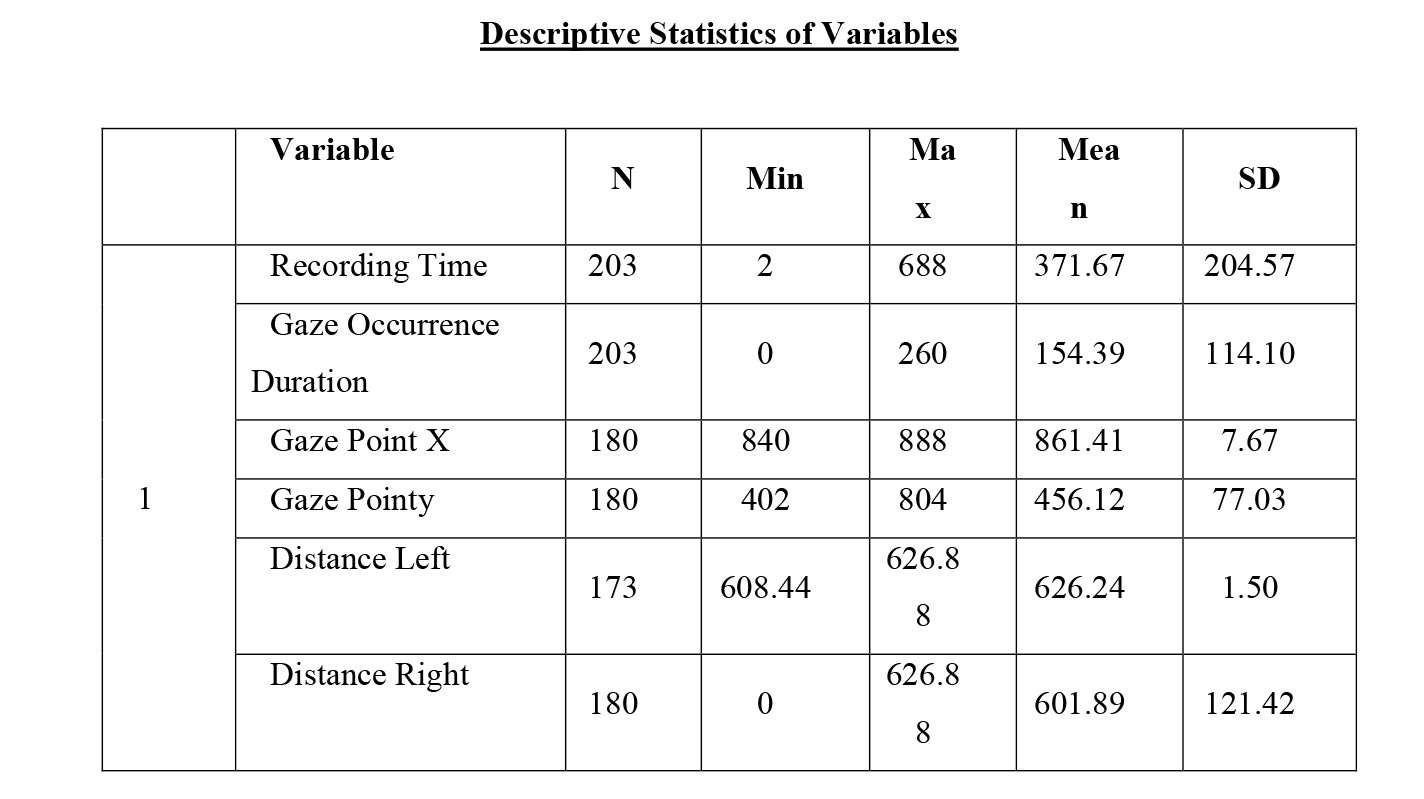
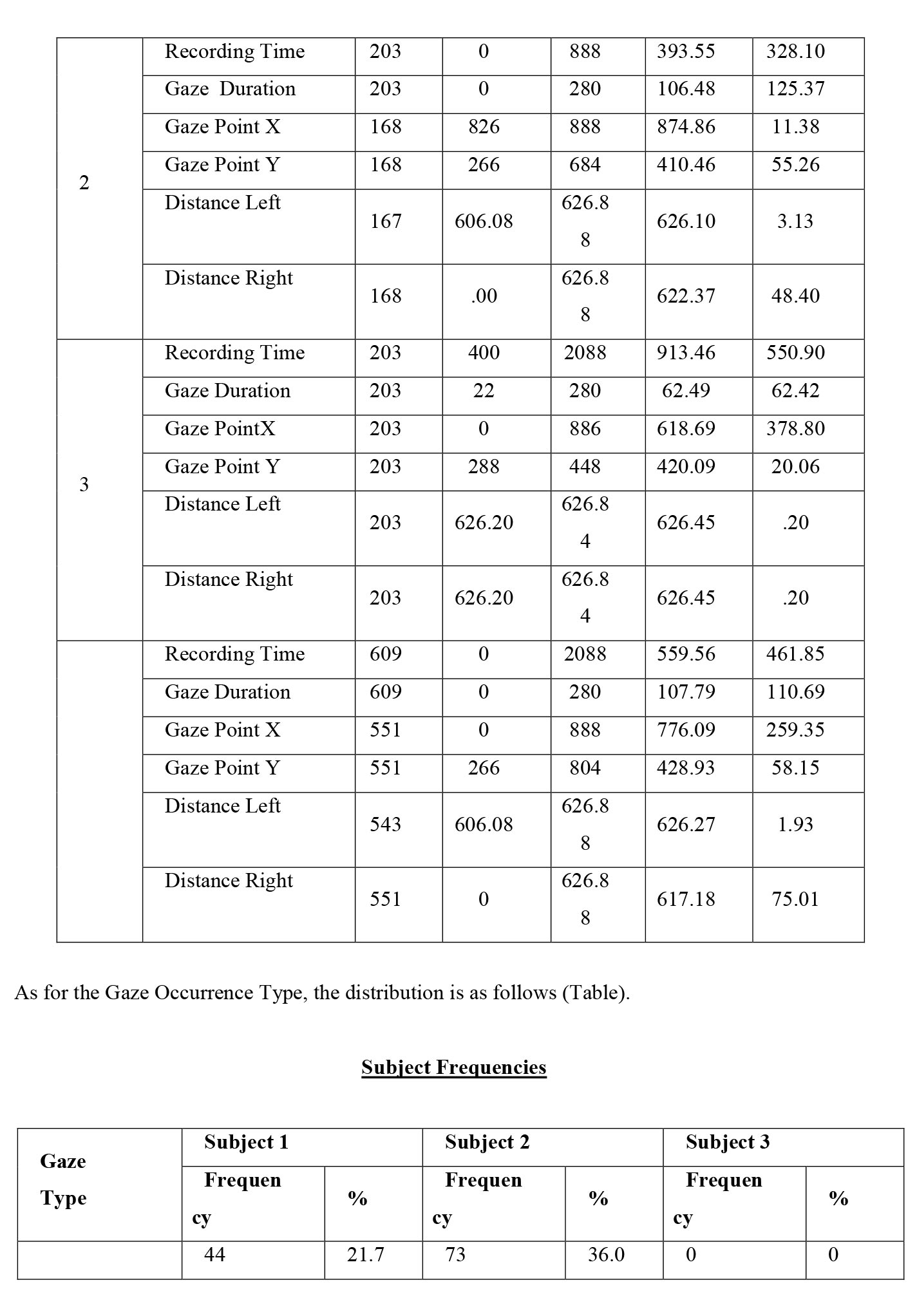
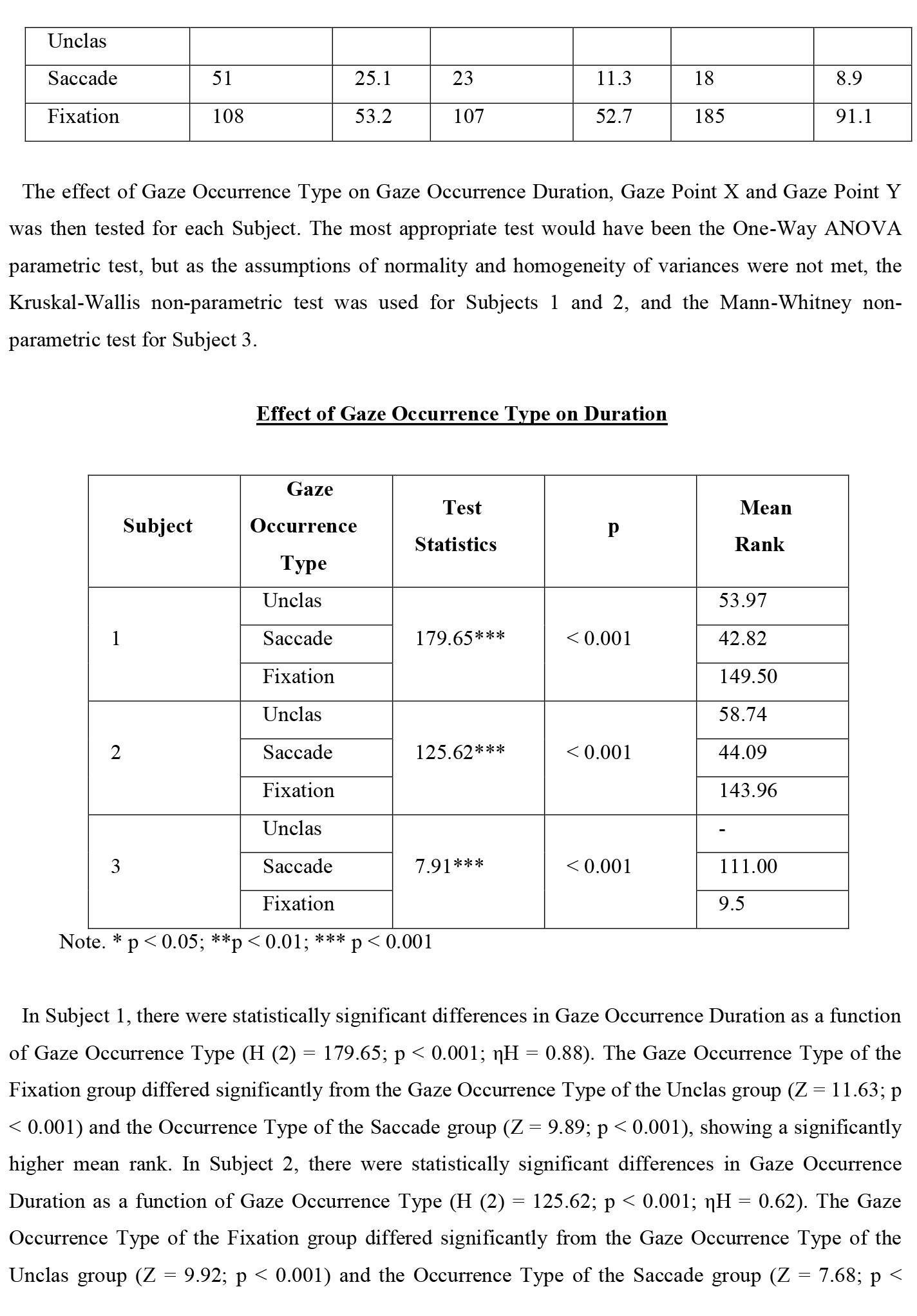
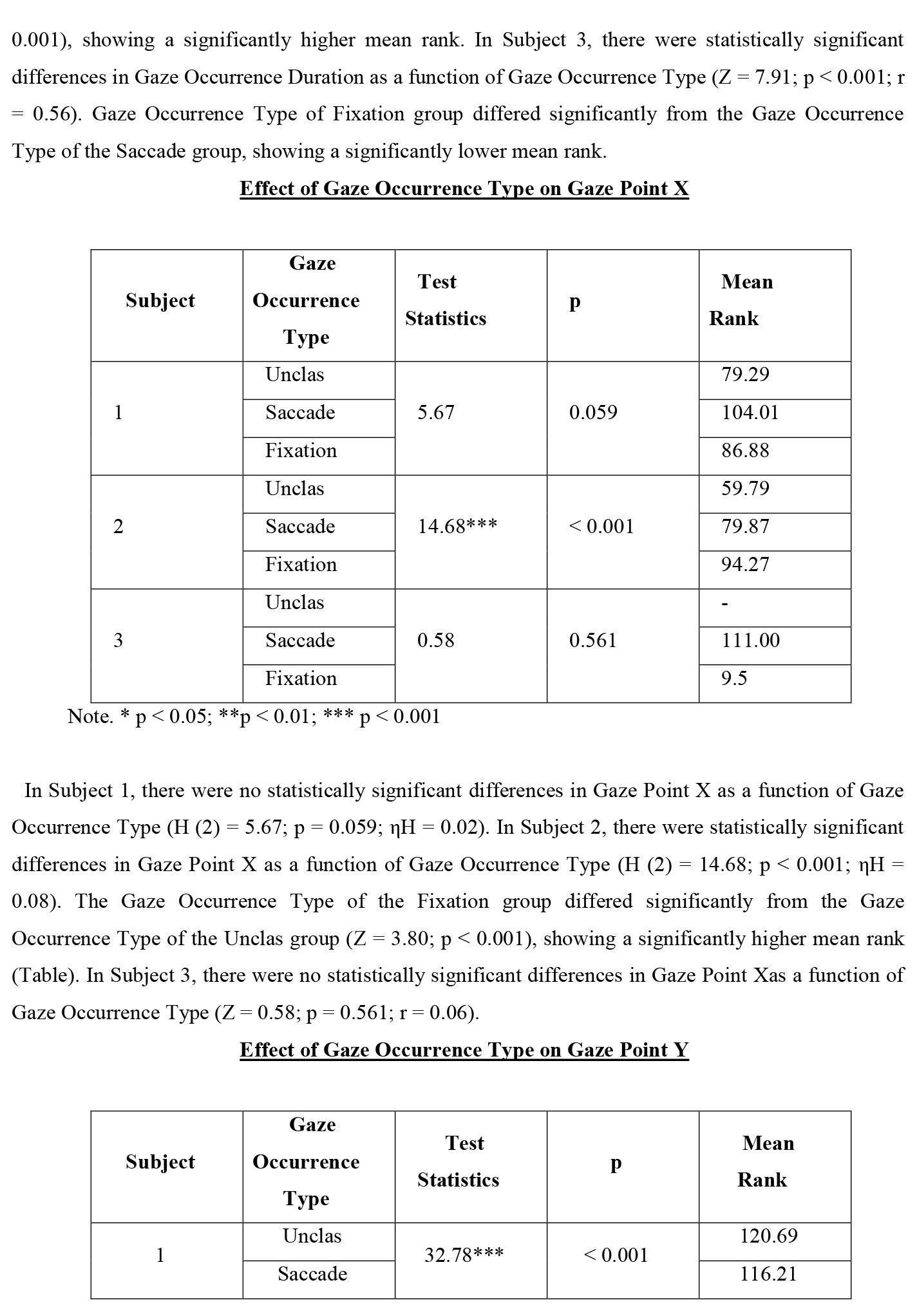
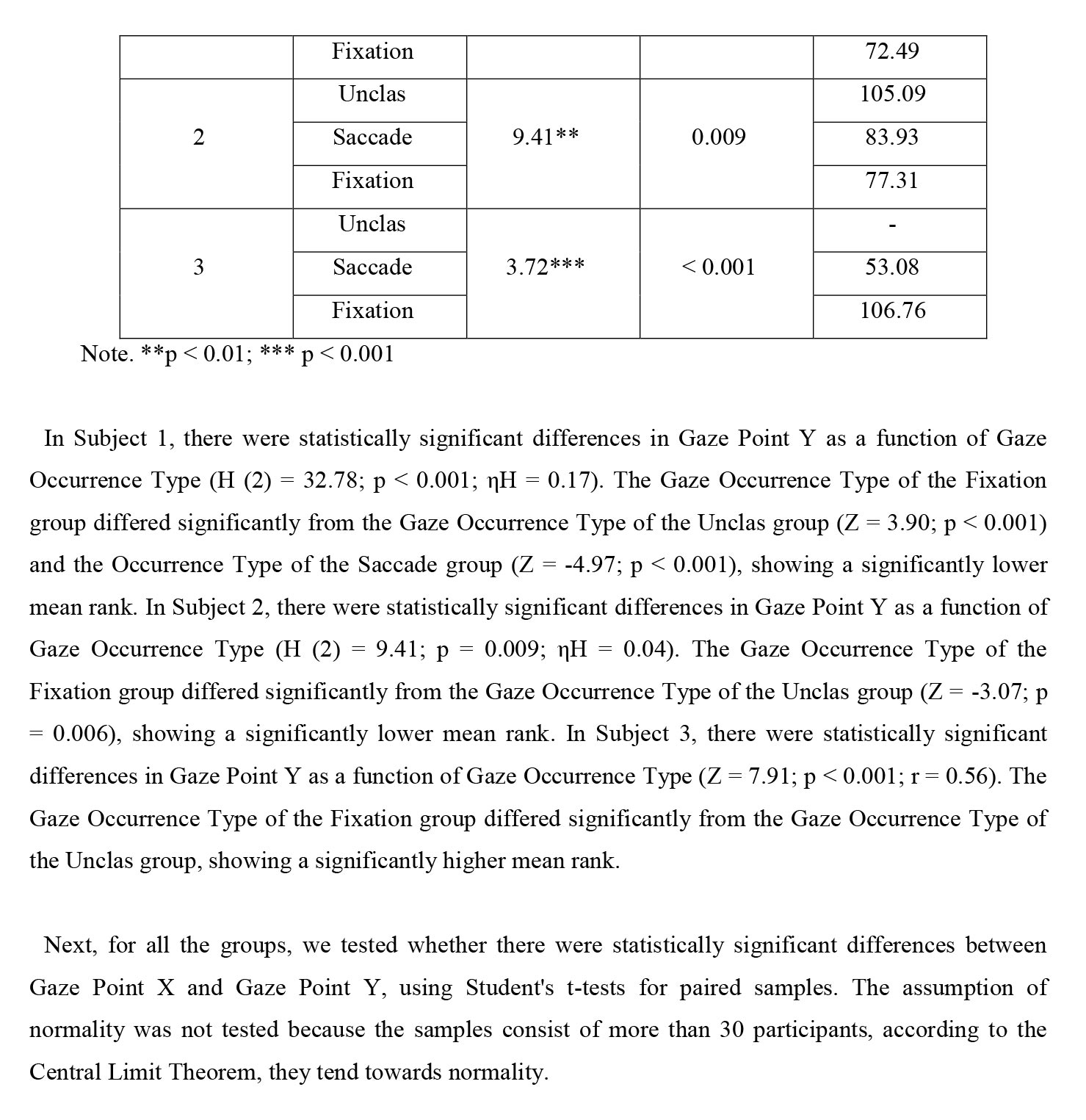
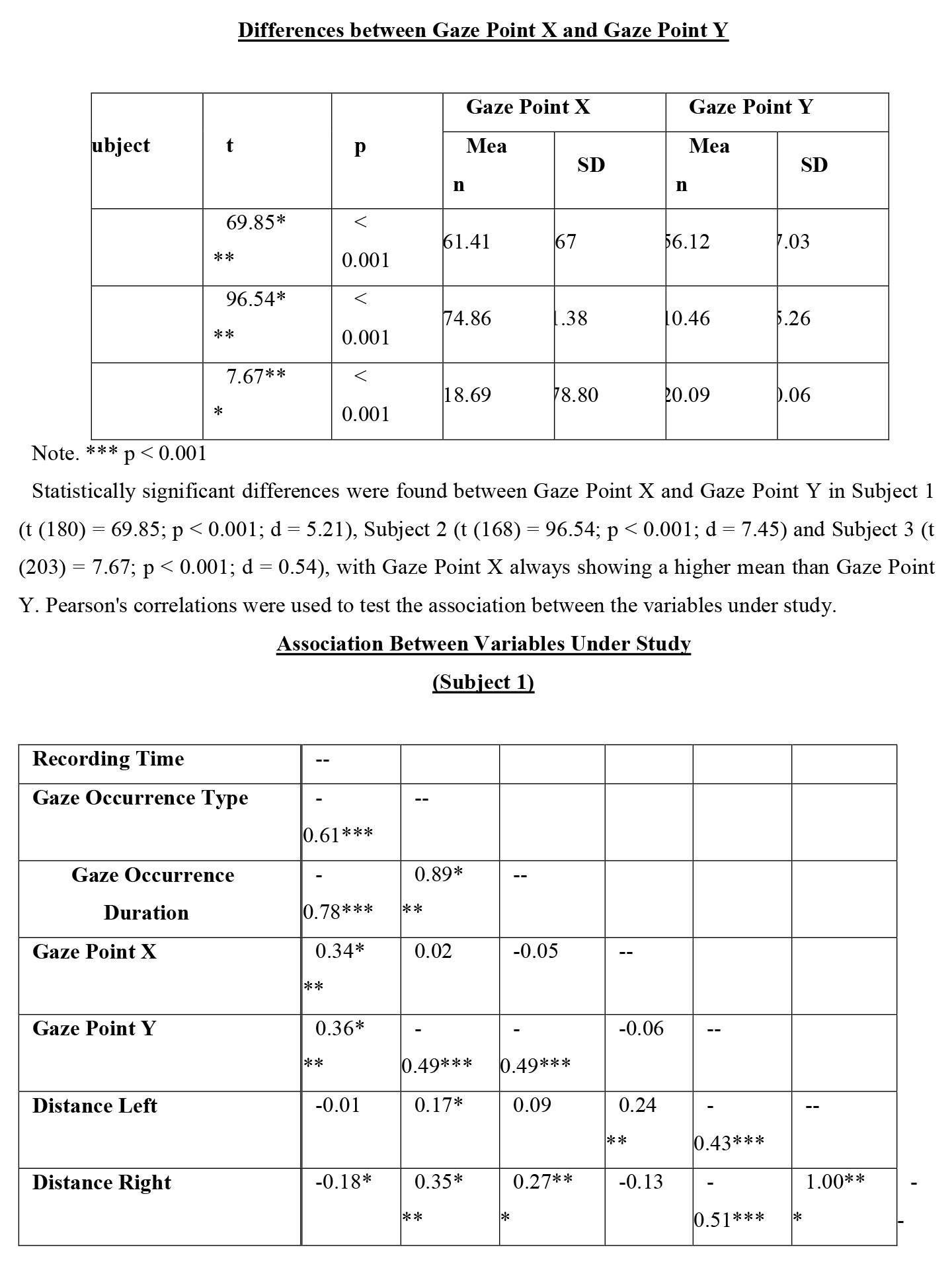
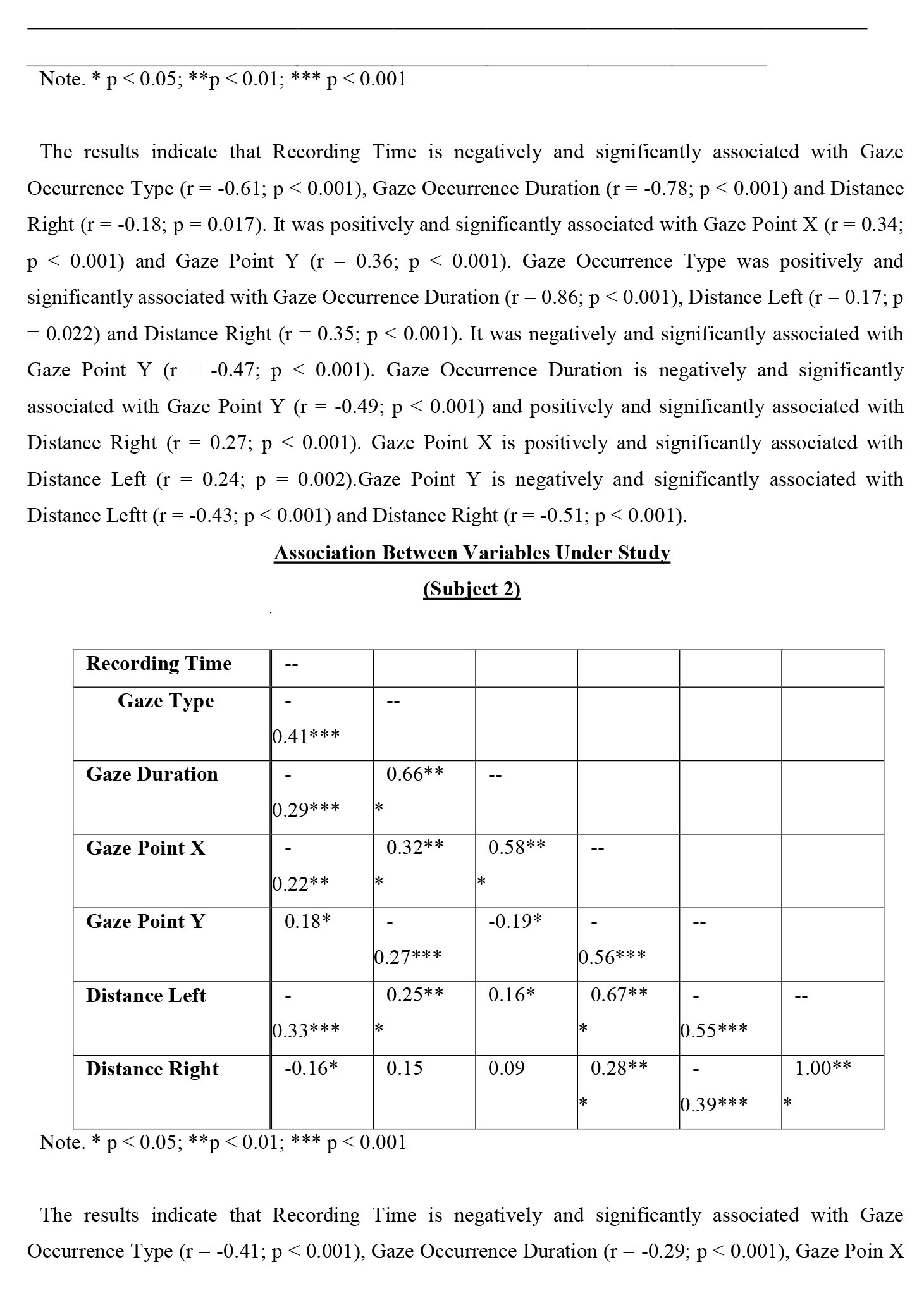
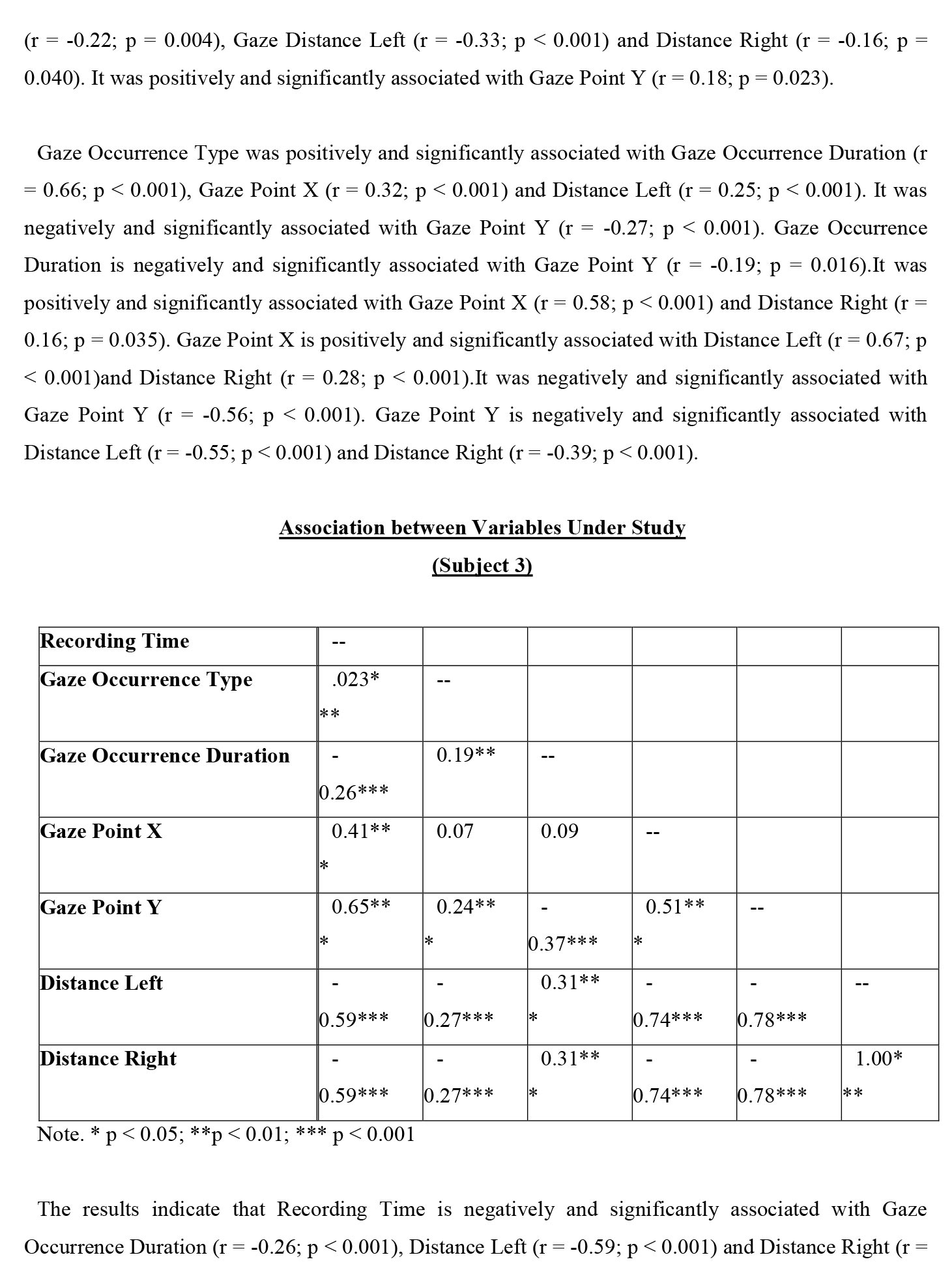
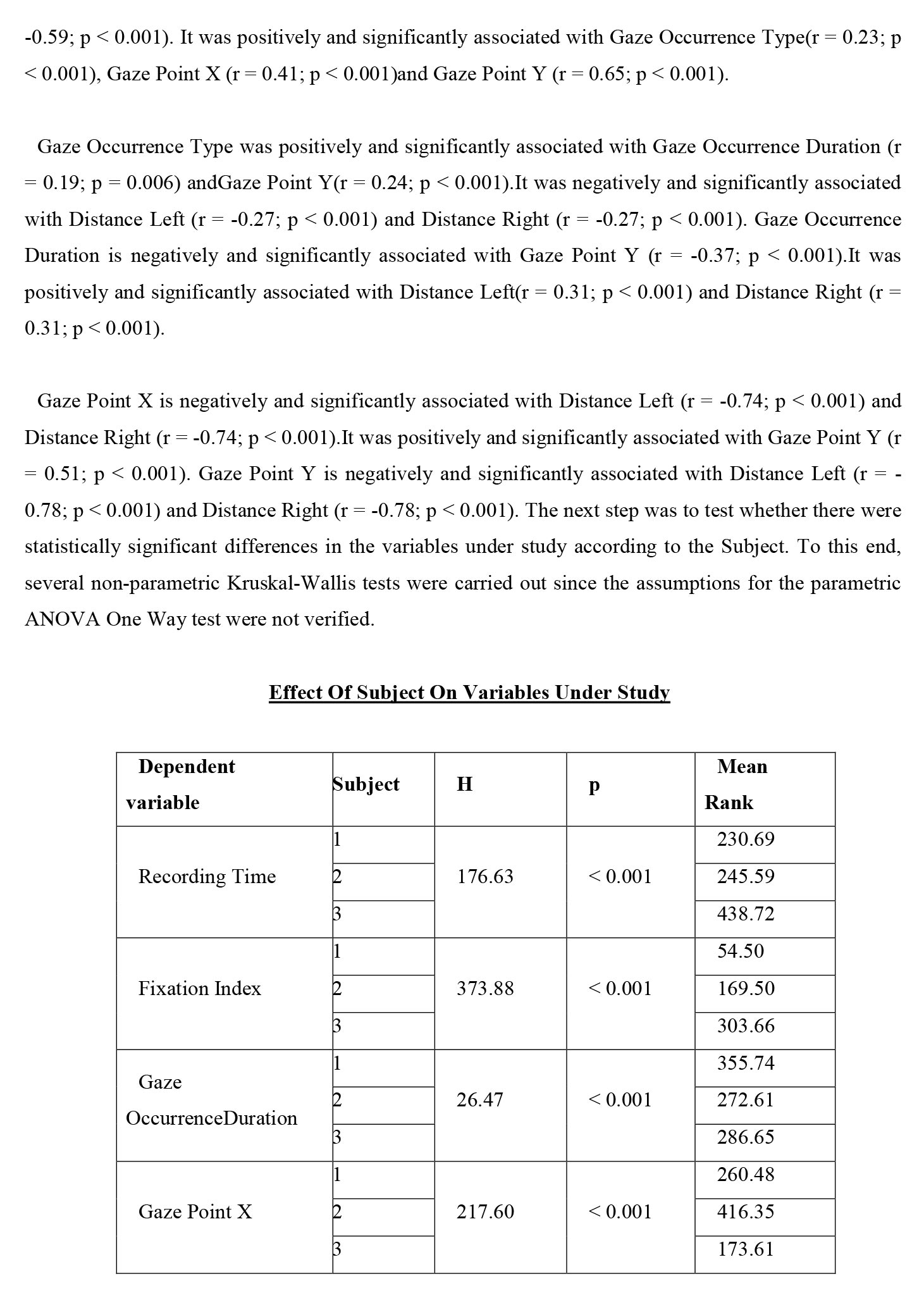
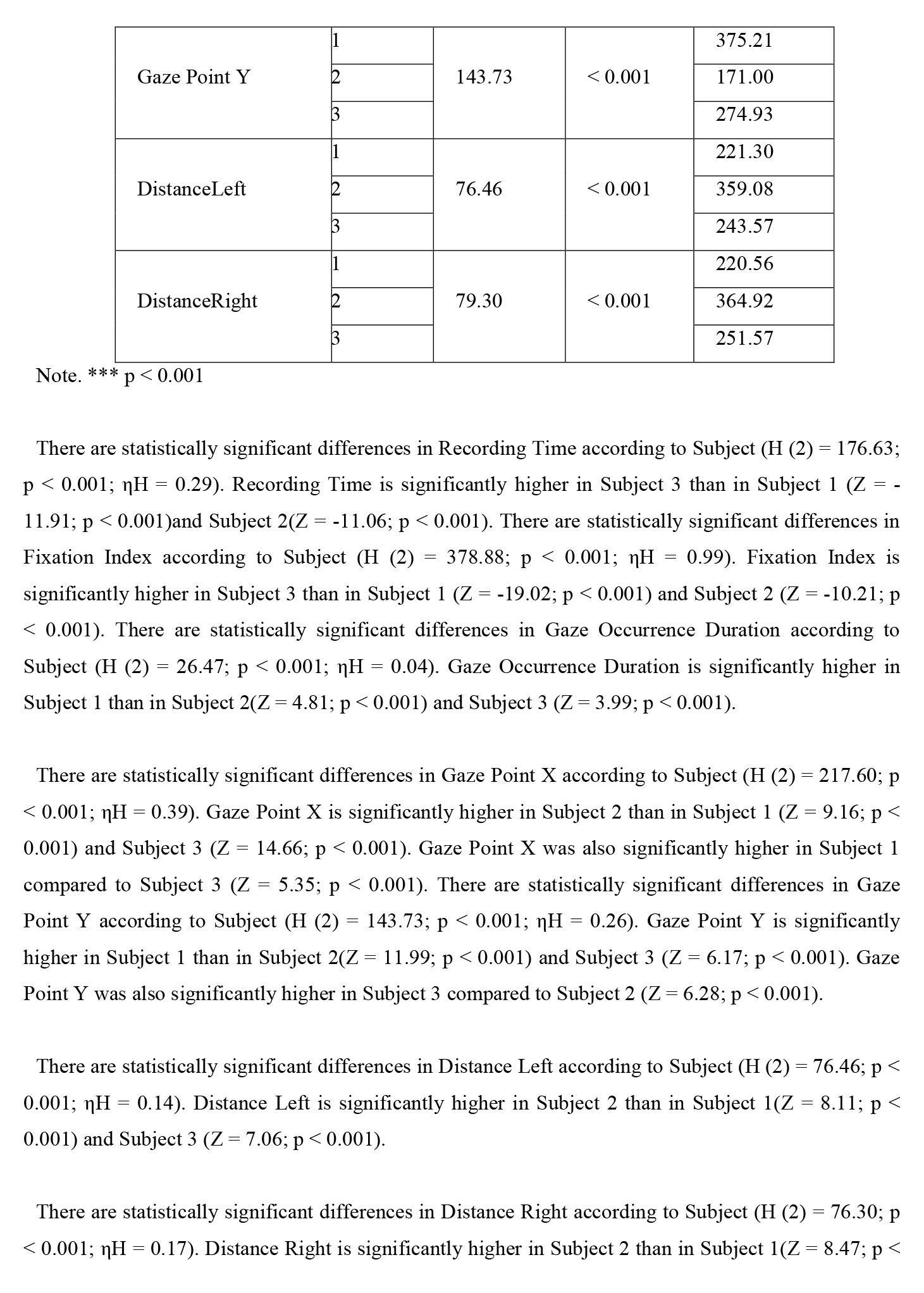

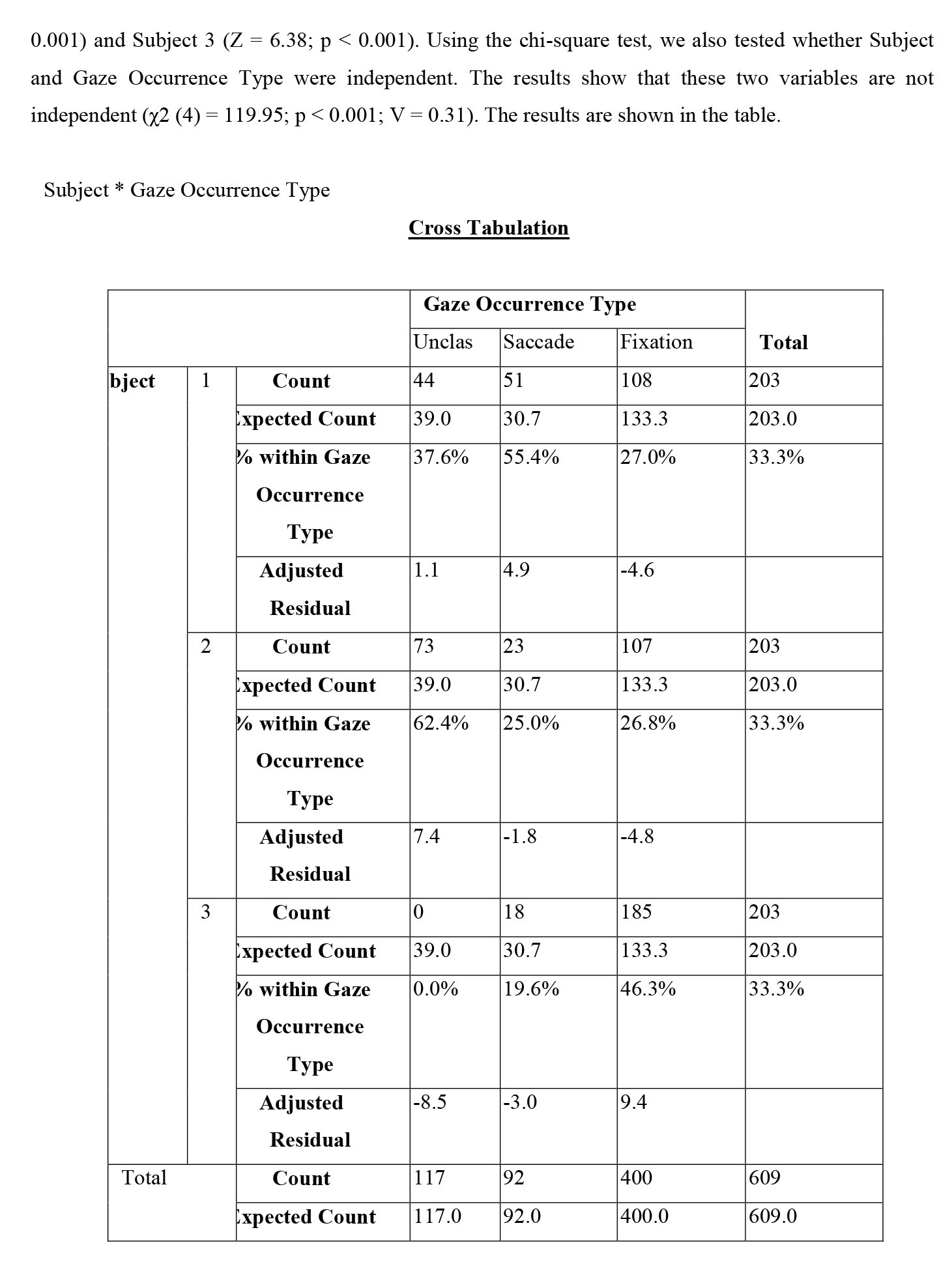
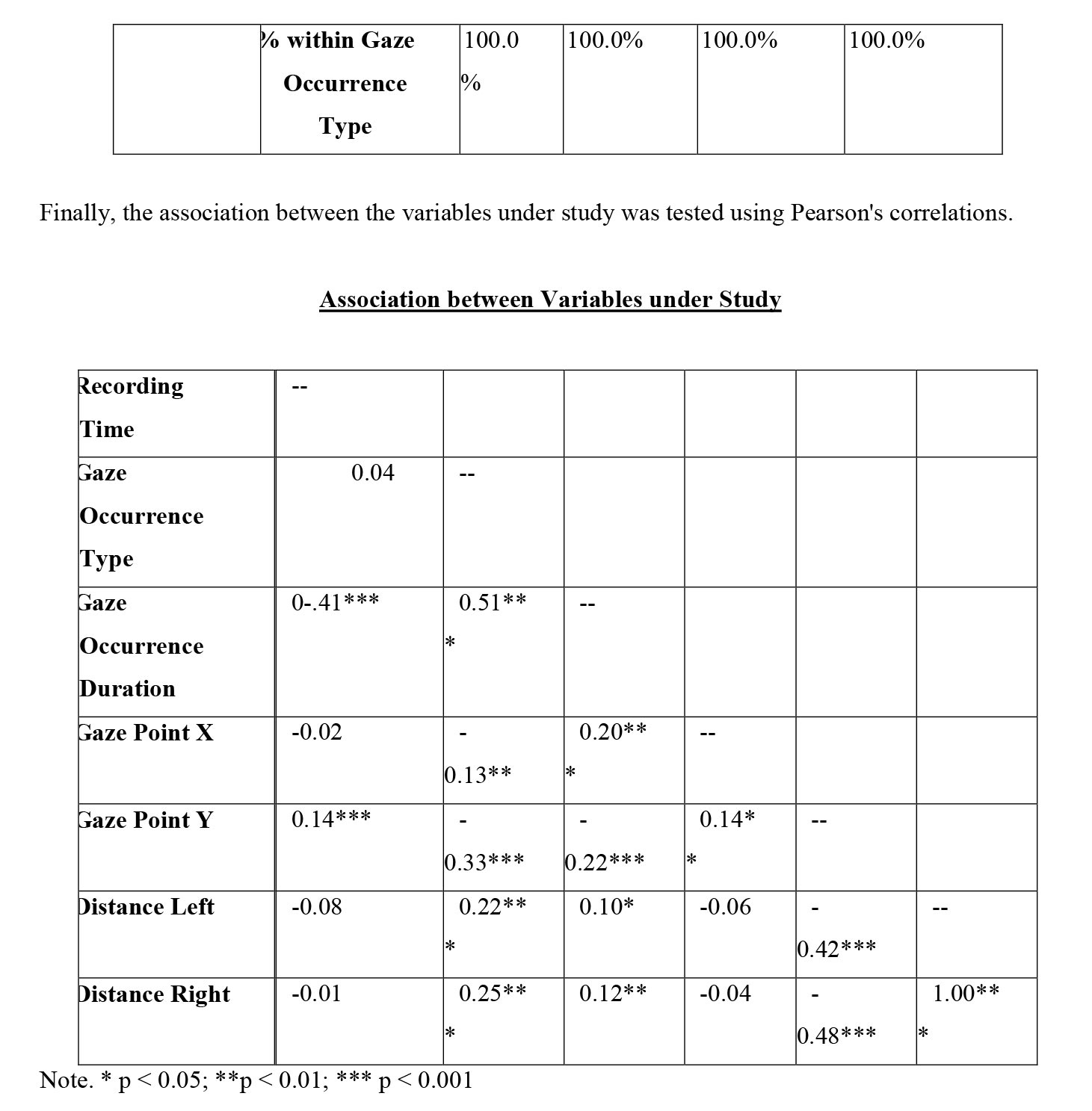
The results indicate that Recording Time is negatively and significantly associated with Gaze Occurrence Duration (r = -0.41; p < 0.001). It was positively and significantly associated with Gaze Point Y (r = 0.15; p < 0.001).
Gaze Occurrence Type was positively and significantly associated with Gaze Occurrence Duration (r = 0.51; p < 0.001), Distance Left (r = 0.22; p < 0.001) and Distance Right (r = 0.25; p < 0.001). It was negatively and significantly associated with Gaze Point X(r = -0.13; p < 0.001) and Gaze Point Y (r = -0.33; p < 0.001). Gaze Occurrence Duration is positively and significantly associated with Gaze Point Y (r = 0.20; p < 0.001), Distance Left (r = 0.10; p = 0.022) and Distance Right (r = 0.12; p = 0.002).It was negatively and significantly associated with Gaze Point Y (r = 0.22; p < 0.001). Gaze Point X is positively and significantly associated with Gaze Point Y (r = 0.14; p < 0.001).Gaze Point Y is negatively and significantly associated with Distance Left (r = -0.42; p < 0.001) and Distance Right (r = -0.48; p < 0.001).
Results (Final/Interim) and Implications
In realm of eye-tracking research, a multitude of parameters provides valuable insights into human behaviour (Tseng, et. al.; 2009). One such parameter that warrants exploration is the fixation recording time (Tseng, et. al.; 2009). This article aims to delve into the intricate details of the correlate subject fixation recording time fixation index gaze occurrence type gaze occurrence duration gaze point X gaze point Y distance left distance right subject I-VT refine, shedding light on its significance and implications for understanding human visual attention (Tseng, et. al.; 2009). In eye-tracking research, one vital aspect is the analysis of various parameters to gain insights into human behaviour (Tseng, et. al.; 2009). One such parameter is the fixation recording time, which refers to the duration for which an individual's gaze remains fixed on a specific point (Tseng, et. al.; 2009). In this article, we will delve into the details of the correlate subject fixation recording time fixation index gaze occurrence type gaze occurrence duration gaze point X gaze point Y distance left distance right subject I-VT refine (Tseng, et. al.; 2009).
Fixation recording time plays a pivotal role in understanding how individuals allocate their attention and process information (Vishwanath, et. al.; 2000). It denotes the period during which the eye remains relatively stationary on a particular region of interest (Vishwanath, et. al.; 2000). By measuring and analyzing fixation-recording times, researchers can identify patterns and draw conclusions about visual processing (Vishwanath, et. al.; 2000). Fixation recording time serves as a window into an individual's cognitive processes, elucidating how attention is allocated and information is processed (Vishwanath, et. al.; 2000). By meticulously analyzing fixation-recording times, we can discern patterns and gain a deeper understanding of visual processing mechanisms (Vishwanath, et. al.; 2000). This valuable metric allows researchers to draw conclusions about the prioritization and duration of focus on specific points of interest within a visual scene (Vishwanath, et. al.; 2000).
Fixation index, on the other hand, is a metric that quantifies the extent to which an individual fixates on a specific region compared to others (Vishwanath, et. al.; 2000). It assesses the concentration of visual attention at a particular point of interest and aids in determining the priority assigned to different elements within a visual scene (Vishwanath, et. al.; 2000). The fixation index is a quantifiable metric that measures the degree of fixation on a particular region of interest relative to others (Vishwanath, et. al.; 2000). It provides insights into concentration of visual attention at specific points, aiding in the assessment of priorities assigned to different elements within a visual stimulus (Vishwanath, et. al.; 2000). By calculating fixation index, researchers can uncover patterns of attention and identify areas of interest that capture subjects' gaze for prolonged periods (Vishwanath, et. al.; 2000).
Gaze occurrence type provides valuable insights into the nature of visual exploration. It categorizes gaze events based on their characteristics, allowing researchers to understand the purpose and intent behind each fixation. Some common gaze occurrence types include fixations, saccades, and smooth pursuit. Gaze occurrence type offers a glimpse into the purpose and intent behind each gaze event. Through categorizing gaze events into fixations, saccades, and smooth pursuits, researchers can comprehend the complexities of visual exploration. This categorization enables a deeper understanding of various gaze behaviours, contributing to the understanding of cognitive processes and perceptual mechanisms.
Gaze occurrence duration refers to the length of time for which a particular gaze event persists. It is an essential aspect of eye-tracking data analysis as it helps in understanding the temporal dynamics of visual attention. Different gaze occurrence durations may indicate varying levels of interest or cognitive processing requirements. Gaze occurrence duration complements the analysis by providing temporal dynamics of visual attention. The duration for which a gaze event persists can indicate varying levels of interest, cognitive processing requirements, or information extraction. Researchers rely on this important parameter to unveil how attention unfolds over time and to illuminate the ebb and flow of visual exploration.
Gaze points X and Y represent the spatial coordinates of an individual's eye gaze (Satpathy; 2023). They provide information about the precise location on a screen or image where attention is focused (Satpathy; 2023). Gaze point X corresponds to the horizontal axis, while gaze point Y corresponds to the vertical axis (Satpathy; 2023). By analyzing these coordinates, researchers can determine which areas of a display or scene attract the most attention (Satpathy; 2023). Gaze point X and Y coordinates provide a precise spatial description of an individual's eye gaze (Satpathy; 2023). These coordinates reveal the exact location on a screen or image that captures attention (Satpathy; 2023). Analyzing these coordinates enables researchers to identify hotspots within a visual stimulus, gaining insight into focal points and areas of high visual saliency (Satpathy; 2023).
Distance left and distance right refer to the horizontal distance between the fixation point and the left and right edges of the display, respectively (Satpathy; 2022). These measurements are essential for understanding gaze patterns and asymmetries in visual exploration (Satpathy; 2022). They can reveal individual preferences or biases in attention distribution across different regions of interest (Satpathy; 2022). To uncover gaze patterns and potential asymmetries in visual exploration, distance left and distance right measurements play a crucial role (Satpathy; 2022). These measurements quantify the horizontal distance between the fixation point and the left and right edges of the display, respectively (Satpathy; 2022). Analyzing these metrics allows researchers to identify individual preferences, biases, or viewing trends that emerge during visual exploration (Satpathy; 2022).
Subject I-VT refine is a methodology used to enhance the accuracy of eye-tracking data by removing artifacts and noise (Kowler; 2022). It involves the application of Velocity Threshold Identification (VTI) algorithms to identify fixations and saccades accurately (Kowler; 2022). Subject I-VT refine provides researchers with cleaner and more reliable data for further analysis (Kowler; 2022). In order to enhance accuracy and reliability of eye-tracking data, researchers employ the subject I-VT refine methodology (Kowler; 2022). This process involves the implementation of Velocity Threshold Identification (VTI) algorithms to identify fixations and saccades with precision (Kowler; 2022). By applying subject I-VT refine, researchers can eliminate artifacts and noise, thereby obtaining cleaner data for further analysis (Kowler; 2022). This approach ensures the integrity and validity of findings derived from eye-tracking studies (Kowler; 2022).
Correlate subject fixation recording time fixation index gaze occurrence type gaze occurrence duration gaze point X gaze point Y distance left distance right subject I-VT refine are vital components in field of eye-tracking research (Kowler; 2022). By understanding and analyzing these parameters, researchers can uncover valuable insights into human visual attention and cognitive processes (Kowler; 2022). The use of high-quality data combined with advanced analysis techniques enables comprehensive exploration of visual behaviour, contributing to better understanding of human perception and decision making (Kowler; 2022).
In conclusion, the correlate subject fixation recording time fixation index gaze occurrence type gaze occurrence duration gaze point X gaze point Y distance left distance right subject I-VT refine parameters serve as vital components in eye-tracking research (Kowler; 2020). By understanding and analyzing these parameters, researchers can gain profound insights into human visual attention, cognitive processes, and decision making (Kowler; 2020). The utilization of high-quality data combined with advanced analysis techniques propels our understanding of human perception to new heights (Kowler; 2020). Consequently, this invaluable knowledge is instrumental in various domains, including psychology, user experience design, marketing, and beyond (Kowler; 2020).
Results calls into question theories localizable to a specific neuromanagement matrix (Satpathy; 2022). Study exhibits key findings, from neuromanagement perspectives within VBTR spectrum and explain how neuro apparatuses explore ‘entrepreneurial choice strategy’ (Satpathy; 2022). Discussion fosters better understanding of direction where VBTR spectrum is heading, and corroborates role of Neuromanagement in this context (Satpathy; 2022). Output is a contribution to co-relation of exploratory research and computational modeling with aim of intensifying use of computational prototypes and replication to explain results for entrepreneurial choice behaviour (Satpathy; 2022). Results advance a model that demonstrates repeatability and specificity in cognitive reactions (Satpathy; 2022). These reflect appropriate results on emblematic entrepreneurial choice behaviour (Satpathy; 2022). Discussion observes EEG as customary so that brain can rupture out of locally ensnared state of affairs (Satpathy; 2022). Discussion propounds fascinating entrepreneurial choice behaviour issues based on scientific understanding of biological processes in choice strategy (Satpathy; 2022). Recommendation is upon reconnoitering fundamentals of entrepreneurial choice behaviour embroidery (Satpathy; 2022). Discussion enhances scientific understanding of biological processes as significant element in entrepreneurial choice behaviour (Satpathy; 2022). Discussion envisions fresh options for development of existential seismicity in VBTR spectrum and concludes with propositions that present directions for future research in VBTR seismicity algorithms.
Contributions
The study of human decision behaviour making and problem solving has attracted attention (Satpathy; 2022). Expanded research proposal requires (model - based empirical) study of behaviour and provide setting for basic research proposal on how ill structured problems are, and can be, solved (Satpathy; 2022). Clinician neuro - human decision behaviour making, which is much less well understood than individual human decision behaviour - making and problem solving, can be studied with great profit using already established methods of inquiry, especially through intensive studies (Satpathy; 2022).
Neuro - optometric management offers solution through series of measurements of eye activity at the time of human decision behaviour (Satpathy; 2022). It provides conceptual and philosophical framework for understanding and conducting research at optometric science, management and psychology spectrum (Satpathy; 2022). Neuro - optometric management theory proposes to build eye-based models capable of predicting observed behaviour (Satpathy; 2022). Neuro - optometric management will shed light on causes of behaviour (and neuro - optometric anomalies) and help build theories capable of explaining and predicting human decision behaviour (Satpathy; 2022). Measurement of eye activity provides information about underlying mechanisms eye during human decision behaviour processes (Satpathy; 2022). Neuro - optometric human decision behaviour modelling would help when new information is inconsistent with goals (Satpathy; 2022). Combining the above disciplines gives interdisciplinary insight to define fundamentals of neuro - optometric human decision behaviour making (Satpathy; 2022).
Complexly interlinked imaging technologies, new imaging technologies have motivated studies of internal order of mind (Satpathy; 2022). Interaction between business and science is not smooth with difference in perception and reasoning potentials on either side (Satpathy; 2022). It suggests fundamental change in how to think, observe and generate choices (Satpathy; 2022). Explorations have extended from neural soundings to stimulating shares of chromatic prospects for rational processing (Satpathy; 2022). Research proposal attempts would discuss findings to understand neuro - design and offer to answer issues in clinician preference embroidery (Satpathy; 2022). Research proposal attempts would conclude with distinctive propositions and presents directions for future research proposal (Satpathy; 2022). Research proposal attempts would aid rethinking foundations of clinician preference embroidery by providing alternative taxonomy for rational preference problems (Satpathy; 2022). This research proposal would open new vistas for future replicative studies (Satpathy; 2022).
Conclusion
Some results supported theory, some results rejected theory, and some results were not significant. What are the mechanisms that keep gaze stable with either stationary or moving targets? How does motion of cognitive image on retina affect vision? Where do (human decision behaviour makers) look - and why - when performing complex task? How can the world appear clear and stable despite continual movements of eyes? Cognitive processes driving eye movements during human decision behaviour making are not in any consequential way different from those in similar tasks (Satpathy; 2022). Eye movements in human decision behaviour making are partially driven by task demands (Satpathy; 2022).
Eye movements in human decision behaviour making are partially driven by stimulus properties that bias information uptake in favor of visually salient stimuli (Satpathy; 2022). Eye movements do not have causal effect on preference formation (Satpathy; 2022). However, through properties inherent to visual system, such as stimulus-driven attention, eye movements do lead to down-stream effects on human decision behaviour making (Satpathy; 2022).
Human decision behaviour makers optimize eye movements to reduce demand on memory and reduce number of fixations and length of saccades needed to complete human decision behaviour task (Satpathy; 2022). Drivers of eye movements in human decision behaviour making change dynamically within tasks (Orquin and Loose; 2013) (Satpathy; 2022). Attention be paid for performing experimental procedures in order to evaluate usability, accuracy and reliability of eye tracking systems (Satpathy; 2022). Any (human decision behaviour) model that aims to describe human decision behaviour making must reflect that visual information play central role in human decision behaviour embroidery (Satpathy; 2022).
REFERENCES
- Aitkin, C.D., Santos, E. & Kowler, E. (2013) Anticipatory smooth eye movements in autism spectrum disorder. PLoS One. 8(12):e83230, 1-11.
- Camerer, C. F. (2003). Behavioural Game Theory: Experiments in Strategic Interaction. Princeton University Press.
- Carmi R., Itti L. (2006). Visual causes versus correlates of attentional selection in dynamic scenes. Vision Research , 46, 4333–4345.
- Carroll, P.J., & Slowiaczek, M.L. (1986). Constraints on semantic priming in reading: A fixation time analysis. Memory & Cognition, 14, 509-522.
- Collewijn,, and Kowler, E. (2008) The significance of microsaccades for vision and oculomotor control. Journal of Vision, 8(14):20, 1-21. (http://journalofvision.org/8/14/20/, doi:10.1167/8.14.20)
- Collewijn, Steinman, R.M., Erkelens, C.J., Pizlo, Z., Kowler, E., and Van der Steen, J. (1992). Binocular gaze control under free-head conditions. In H. Shimazu and Y. Shinoda. Vestibular and Brain Stem Control of Eye, Head and Body Movements. Basel: Karger.
- Damasio, A. R. (1994). Descartes' Error: Emotion, Reason, and the Human Brain. Penguin Books.
- Kowler, E. (1989). Cognitive expectations, not habits, control anticipatory smooth oculomotor pursuit. Vision Research, 29, 1049-1057.
- Kowler, E. (1990). The role of visual and cognitive processes in the control of eye movement. In E. Kowler. Eye Movements and Their Role in Visual and Cognitive Processes. Amsterdam: Elsevier.
- Kowler, E. (1991). The stability of gaze and its implications for vision. In R.H.S. Carpenter. Eye Movements (Volume 9 of Vision and Visual Dysfunction). London: Macmillan Press
- Kowler, E. (1995) Cogito ergo moveo: Cognitive control of eye movement. In M. Landy, L. Maloney and M. Pavel. Exploratory Vision: The active eye. N.Y.: Springer-Verlag. Pp. 51-77.
- Kowler, E. (1995) Eye movement. In S. Kosslyn. Invitation to Cognitive Science, Vol. 2. . Cambridge: MIT Press.
- Kowler, E. (1999) Eye movements and visual attention. In: MIT Encyclopedia of Cognitive Science. Cambridge: MIT Press.
- Kowler, E. (2006) The basis of a saccadic decision: what we can learn from visual search and visual attention. In Seeing Spatial Form. (Editors M.R.M. Jenkins and L.R. Harris). NY: Oxford University Press. (pp. 169-186).
- Kowler, E. and Blaser, E. (1995) The accuracy and precision of saccades to small and large targets. Vision Research, 35, 1741-1754.
- Kowler, E. and Collewijn,, (2010) Eye movements: Behaviour. In Sage Encyclopedia of Perception.
- Kowler, E. and Martins, A. J. (1982). Eye movements of preschool children. Science, 215, 997-999.
- Kowler, E. and Martins, A. J. (1983). Eye movements of preschool children (Technical comment). Science, 222, 75-77.
- Kowler, E. and McKee, S. M. (1987). Sensitivity smooth eye movements to small differences in target velocity. Vision Research, 27, 993-1015.
- Kowler, E. and Sperling, G. (1980). Transient stimulation does not aid visual search: Implications for the role of saccades. Perception and Psychophysics, 27, 1-10.
- Kowler, E. and Sperling, G. (1983). Abrupt onsets do not aid visual search. Perception and Psychophysics, 34, 307-313.
- Kowler, E. and Steinman, R. M. (1977). The role of small saccades in counting. Vision Research, 17, 141-146.
- Kowler, E. and Steinman, R. M. (1979). Miniature saccades: Eye movements that do not count. Vision Research, 19, 105-108.
- Kowler, E. and Steinman, R. M. (1979). The effect of expectations on slow oculomotor control--I: Periodic target steps. Vision Research, 19, 619-632.
- Kowler, E. and Steinman, R. M. (1979). The effect of expectations on slow oculomotor control--II: Single target displacements. Vision Research, 9, 633-646.
- Kowler, E. and Steinman, R. M. (1980). Small saccades serve no useful purpose. Vision Research, 20, 273-276.
- Kowler, E. and Steinman, R. M. (1981). The effect of expectations on slow oculomotor control-III: Guessing unpredictable target displacements. Vision Research, 21, 191-203.
- Kowler, E., Aitkin, C.D., Ross, N.M., Santos, E.M. & Zhao, M. (2014). Davida Teller Award Lecture: The importance of prediction and anticipation in the control of smooth pursuit eye movements. Journal of Vision, 14(5):10, 1-16. doi 10.1167/14.5.10
- Kowler, E., and Zingale, C. (1985). Smooth eye movements as indicators of selective attention. In M.I. Posner, & O.S.M. Marin. Attention and Performance XI. Hillsdale, NJ: Erlbaum.
- Kowler, E., Anderson, E., Dosher, B. and Blaser, E. (1995) The role of attention in the programming of saccades. Vision Research, 35, 1897-1916.
- Kowler, E., Martins, A. J., and Pavel, M. (1984). The effect of expectations on slow oculomotor control--IV: Anticipatory smooth eye movements depend on prior target motions. Vision Research, 24, 197-210.
- Kowler, E., Murphy, B. J. and Steinman, R. M. (1978). Velocity matching during smooth pursuit of different targets on different backgrounds. Vision Research, 18, 603-605.
- Kowler, E., Pizlo, Z., Zhu, G.L., Erkelens, C., Steinman, R.M., and Collewijn,, (1991). Coordination of head and eyes during the performance of natural (and unnatural) visual tasks. In A. Berthoz, W. Graf, and P.P. Vidal. The Head-Neck Sensory Motor System. N.Y.: Oxford University Press.
- Kowler, E., Rubinstein, J.F., Santos, E.M., & Wang, J (2019) Predictive smooth pursuit eye movements. Annual Re of Vision Science, 5, 223-246.
- Potter, M. (1999). Understanding Sentences and Scenes: The role of conceptual short-term memory. In V. Coltheart (Ed.), Fleeting Memories, (pp. 13-46). Boston: MIT Press.
- Sahoo, K. and Satpathy, J. (2021). Alarms in Entrepreneurial Quasi-Rational Decisions, Proceedings of 07 th International Conference on Global Business Environment, IMI - EGADE Spain, December 10-11, 2021, Paper Id: 56 IMI Bhubaneswar, India (International).
- Sahoo, K. and Satpathy, J. and Laza, S. (2021). Philosophical Undercurrents in Neuro - Organizational Economic Behaviour, IJAEM, Volume 3, Issue. 11, Pp: 381 - 409, Nov. 2021, DOI: 10.35629/5252-0311381409, Impact Factor value: 7.429, India (International).
- Sahoo, K. and Satpathy, J. Mohanty, V., Subramanium, K. & Raj, K. (2021). Cognito - Tectonics in Stress Induced Emotional Behaviour, Journal of YMER, / ISSN: 0044-0477, Volume 20: Issue 11, DOI Number: 10.37896 / YMER, 20.11 / 31, (Nov) 2021, Pp: 340 - 368, India (International). Scopus
- Sahoo, K., Satpathy, J., Raj, K. and Aithal, P.S. (2021). Neuro - Experimentations in Emotive Continuum, Proceedings of International Conference on Academic Research and Innovation in Management, IT, Social Science and Education) ICARI), 24 - 25 Nov 2021, Srinivas University, Mangaluru, India in collaboration with European International University, Paris, France (International).
- Satpathy, J, (2023). Neuro-Substantiations in Complex Economic Choices, Proceedings of the International Conference on Contemporary Trends in Commerce and Management, St. Francis College, Bengaluru University, 30 June 2023, Bengaluru, India (International).
- Satpathy, J, Aithal, P.S., Okeyo, W., Misra, L., Lidija, W., Subramanian, K., Singh, A., Roza, J., Chowdhury, D. and Weir, D. (2023). Neuro - Probabilistic Heterodoxian Functionalism in Decision Endoscopy, Bulletin for Technology & History Journal, ISSN No: 0391-6715, Vol. 23, Issue. 06, Pp: 01 - 46, DOI: 10.37326 / bthnlv22.1 /1263, Manuscript ID: BTH / 1734, India (International). Scopus
- Satpathy, J, Aithal, P.S., Torben, L., Roza, J., Chin, P. N., Lockhart, J., Chowdhury, D., & Misra, L. (2023). Fluid Intelligence in Unpredictability Behaviour, Bulletin for Technology & History Journal, ISSN No: 0391-6715, Vol. 23, Issue. 05, Pp: 368 - 383, DOI: 10.37326 / bthnlv22.1 /1263, Manuscript ID: BTH / 1724, India (International). Scopus
- Satpathy, J, Fariba, A., Okeyo, W., P. S., Torben, L., Lockhart, J., Misra, L., Mageswari, R., Torben, L., Ana, H.A.R., Mohd, Salmai, I., Kavitha, S., Sabri, O. and Warrier, U. (2023). Neuro-Drivers in Entrepreneurial Decision Anxiety, Proceedings of 5th International Spring Conferences, 26 May 2023, Pages 22 – 24, Istanbul Commerce University, Istanbul, Turkey (International).
- Satpathy, J. & Sahoo, K. (2021). Behavioural Humanomics in Anthropoid Brain, International Research Journal of Modernization in Engineering Technology and Science, e-ISSN: 2582-5208, Volume:03/Issue:11/November - 2021, Pp: 264 - 282, India (International).
- Satpathy, J. & Sahoo, K. (2021). Neuro - Scans on Economic Decision Interregnums, The British Journal of Biological Studies, Vol. 1, No. 1 (2021), DOI: 10.32996/bjbs.2021.1.1.2, Pp: 11 - 41, Hanwell, London, UK (International).
- Satpathy, J. & Sahoo, K. (2022). Brain - Eye Co - Adjuvancy in Military Decision Dynamics, Proceedings of 57th National and 26th International Conference of Indian Academy of Applied Psychology (2022), Department of Clinical Psychology and Department of Psychology, 27-29 January 2022, Mizoram University, Aizawl, Mizoram, India (International).
- Satpathy, J. & Satpathy, M. (2022). Cognito - Tectonics in Stress Induced Emotional Behaviour, Poster, Poster No. C - 17, 9th Mind-Brain-Body Symposium 2022, 16 - 18 March 2022, Max Planck Institute for Human Cognitive and Brain Sciences, Leipzig, Germany (International).
- Satpathy, J. & Saufi, R. B. A. (2021). Noise Sensitivity in VUCA Decision Scenario, International Conference on Sustainable Excellence in Business and Entrepreneurship, Techno India School of Management, 25 - 26 Nov 2021, Kolkatta, India (International).
- Satpathy, J. (2020). Neuro - Milieus in Technopreneurial Choices, National Seminar on ‘Entrepreneurship and Technology: Future trends’, Army Institute of Law, 27 Nov, Mohali, India (National).
- Satpathy, J. (2020). Neuro - Perspectives in Managerial Decisions: An Anthology, Odisha Journal of Social Science, OJSS, Vol.07, Issue - 01, Pp: 60 - 66 Jan, 2020, Bhubaneswar, Odisha, India (National).
- Satpathy, J. (2020). Neuro - Trajectories in Decision Making, Proceedings of 5th International Conference (INCONSYM 2020) on Business Transformation in Global Digital Era: Re-Innovator - Strategize and Re - Model, 21- 22 Feb 2020, Symbiosis Centre for Management Studies, Symbiosis University, NOIDA, Delhi, India (International).
- Satpathy, J. (2020). Neuro - Trajectories in Technology - Driven Managerial Decisions, Proceedings of International Conference on Research, Innovation, Knowledge Management and Technology Application for Business Sustainability, 19 - 21 Feb 2020, INBUSH ERA World Summit, Amity University, NOIDA, India (International).
- Satpathy, J. (2021). Heretical Gradients in Entrepreneurial Choice, Proceedings of 07th International Conference on Global Business Environment, IMI - EGADE Spain, December 10 - 11, 2021, Paper Id: 56 IMI Bhubaneswar, India (International).
- Satpathy, J. (2023). Neuro - Ophthalmology in Agricultural Decisions, Proceedings of International Conference on Contemporary Economy in Post - Covid Era [CEPCE], Feb 17 - 18 2023, BJB Autonomous College, Bhubaneswar, India, (International).
- Satpathy, J. (2023). Neuro-Psychological Signatures in C4 Decisions, Proceedings of International Conference on Strategic Business Decisions for Sustainable Development, 01 - 02 Mar 2023, E-ISBN: 978-81-946660-4-2, Department of Commerce, B.S. Abdur Rahman Crescent Institute of Science and Technology, Vandalur, Chennai, India , 05 May 2023, Bhubaneswar, India (International). Published by Alborear (OPC) Publishers, Aravali, Sanghvi Hills, Ghodbander Road Thane - 400607, Maharashtra, India (National).
- Satpathy, J. (2023). Pluralist Behavioural Economics (Repositioning In VUCA - BANI Seismicity), International Conference on Thriving in Turbulent Times: Sustainable Growth through Innovative Practices, 9th & 10th August 2023, Departments of Commerce & Innovation Council, Women's Christian College, Chennai, India (International).
- Satpathy, J. and Aithal, P.S. (2023). Hetero - Canonical Computation in Eye Tracking Modeling, Proceedings of the National Virtual Conference on Future Trends in Information Communication and Computing Technology (NCFTICCT), Srinivas University Research Enclave, 22 July 2023, Department of Computer Science & Engineering and Institute of Information Science and Computer Science, Srinivas University, Mangaluru, India
- Satpathy, J. and Gankar, S. (2020). Behavioural Neuromangement in Coronomics (Extended Abstract), National Zoominar on ‘Life After COVID - 19 Pandemic and Rebooting Economy’, S. B. Patil Institute of Management Conference and Pune Business School, 13 June, Pune, India (National).
- Satpathy, J. and Gera, S. (2020). Random Reflections on Neurodecisions Dynamics, Odisha Journal of Social Science, OJSS, Vol.07, Issue - 01, Pp: 67 - 74, Jan, 2020, Bhubaneswar, Odisha, India (National).
- Satpathy, J. and Hejmadi, A. & Weis, L. (2022). Neuro Soundings in Data - Driven Entrepreneurial Decisions, Paper presented at the International Virtual Conference on Cognitive Approach, Social Ethics and Sustainability, 23 - 24 Nov 2022, Woxsen University, Hyderabad, Telengana, India (International).
- Satpathy, J. and Hejmadi, A. (2020). Neuro - Smidgeons in Choosing to Decide (Poster), Proceedings of NeuroPsychoEconomics Conference, Serial: Pp: 08, 11 - 12 June 2020, NeuroPsychoEconomics Conference (Zoom), (International).
- Satpathy, J. and Juster, G. N., (2022). Revised Estimates in Choice Guestimates, 9th International Conference on Redefining Organizational Leadership & Management Towards Post Covid - 19 Pandemic, 15 - 16 Sep 2022, The Management University of Africa, Nairobi, Kenya (International).
- Satpathy, J. and Mallik, B. (2020). Computational ‘Neuro - Trajectories’ in Decision Making, National Seminar on Mathematical Analysis and Computing (ACOMS 2020) and Proceedings of 47th Conference of Odisha Mathematical Society, Dept. of Mathematics, National Institute of Science and Technology (Autonomous), Berhampur, 15 - 16 Feb 2020, Odisha, India (National).
- Satpathy, J. and Mishra, D. P. (2020). Cognitive Reconnaissance in Lending Comportment, Journal of Mukt Shabd, UGC - CARE Group - I Journal, ISSN: 2347 - 3150, Vol. IX, Issue IV (Special Issue - 2020 - 1), April, Pp: 56 - 73, Hyderabad, India (National).
- Satpathy, J. and Mishra, D. P. (2020). Neuro - Heterodoxies in Loan Decision Topography, Journal of Information and Computational Science, ISSN 1548 - 771, UGC - CARE Group II Journal, Volume 10, Issue 03, Pp: 963 - 975, India (International).
- Satpathy, J. and Neena, P. C. (2020). Neuro - Trajectories in Managerial Decisions, Proceedings of the National Conference on Application of Analytics in Business Reengineering, 07 March 2020, Christ University, Lavasa, Pune, Maharashtra. India (National). Printed as a Conference Proceeding in Journal of Xi'an University of Architecture and Technology, ISSN No: 1006-7930, Volume XI, Issue XII, 2019, Pp: 1140 - 1147, Xi'an University of Architecture and Technology, Xian, Shaanxi Province, Peoples Republic of China (International). Scopus
- Satpathy, J. et. al. (202). e Study: Disruptive Blood Guestimates in Preference Circuits, Pramana Research Journal, ISSN No. 2249 – 2976, Volume 11, Issue 07, 2021, Pp: 45 - 74, India (National).
- Satpathy, J. et.al. (2022). Managerial Neuro - Heterodox Attitude in Disordered Scenario, Journal of YMER, / ISSN: 0044-0477, Volume 21: Issue 01, DOI Number: 10.37896 / YMER, 20.11 / 31, (Jan) 2022, Pp: 577 - 604, India (International). Scopus
- Satpathy, J. Laza, S. & Mund, S. (2022). Retrospective on Reason and Emotion, Proceedings of CMC and Emotion Workshop, June 06 - 07, Department of Psychology and Institute for Learning and Brain Sciences, University of Washington, Seattle, USA (International).
- Satpathy, J., Aithal, P.S., Misra, L., Singh, A., Lockhart, J, Rolle, J.A., & Dima, J. (2023). Neuro - Probabilistic Functionalism Endoscopy in Brunswick’s Lens Decisions, Proceedings of International Conference on Innovations & Advances in Management and IT, Initiatives, Catalysts and Impacts, Aug 25 - 26, 2023, International School of Informatics & Management, Jaipur, India, (International).
- Satpathy, J., Aithal, P.S., Okeyo, W., Singh, A., Misra, L., Laza, S., Lockhart, J. and Torben, L. (2023). Neuro - Economic Soundings In Industry 7.0, Being presented at the International Seminar on Accounting, Finance, Business and Social Sciences (ISAFBS’23), September 14 - 16th, 2023, Dept. of Business Administration, Assam University, Silchar (India) in collaboration with Alabama A & M University, USA and Department of Management, North Eastern Hill University, Shillong, India (International). Forthcoming
- Satpathy, J., and Thomas, T. (2023). Emerging Trends in Optometric Design Approximations, International Seminar on Digital Innovations in Business and Finance, ICSSR, New Delhi, 26 - 27 April 2023, Bharat Mata College, Kerala, India, Colombo University, Colombo, Sri Lanka, Sankara College, Coimbatore, and Mahatma Gandhi University, India (International).
- Satpathy, J., Das, A. & Okeyo, W. (2021). Conscience Based Hemato - Cerebral Decision Values, Proceedings of National Seminar on ‘Value Based Management, 23 - 24 March 2021, Acharya Nagarjuna University, Ongole, Andhra Pradesh, India (National).
- Satpathy, J., Das, A. and Panda, M. and Gankar, S. (2020). Neuro - Cursors in Entrepreneurial ‘Choice Mosaic’, Journal of Juni Khyat, UGC - CARE Group I Journal, ISSN: 2278 - 4632, Volume 10, Issue 05 (14), Pp: 383 - 391, India (National).
- Satpathy, J., Das, A., Laza, S. and Hejmadi, A. (2020). Experiment in Neuroentrepreneurial ‘Preference’, Journal of Juni Khyat, UGC - CARE Group I Journal, ISSN: 2278 - 4632, Volume 10, Issue 05 (06), Pp: 86 - 99, India (National).
- Satpathy, J., Das, A., Okeyo, W. and Maddali, S. S. (2021). Disruptive Neuro - Heretical in Heterodox Decision Management, Proceedings of International Conference on International Conference on ‘Managing Inflection Point in Changing Landscape: Through Technological Innovations (ICMIC21), Institute of Management Studies, Ghaziabad, 24 Apr 2021, Ghaziabad, India (International).
- Satpathy, J., Gankar, S, S., and Okeyo, W. (2021). Anthological Commentary on Cerebral Guesstimates, Journal of STEAM, Vol. 01, Issue.02, August, Pp: 29 - 55, D Y Patil University, Ambi, Pune, Maharashtra (India). (National).
- Satpathy, J., Gankar, S, S., Malik, B, Okeyo, W. and Chhaniwal P. (2021). Hematological Signatures in Technopreneurial Decision Corridors, Proceedings of the NIRMA International Conference on Management (NICOM - 2021), 07 - 09 Jan 201, Ahmedabad, Gujarat (India). (International).
- Satpathy, J., Gankar, S. and Patnaik, J. (2020). Neuro - Couplings in Managerial Choice Preference, IUJ Journal of Management (IUJJOM), ISSN: 2347 - 5080, EOI: 10.11224 / IUJ, Volume 08, Issue. 01, Pp: 79 - 91, June, ICFAI University Jharkhand, India (National).
- Satpathy, J., Gankar, S.S., Hejmadi, A. and Malik, B. (2021). Hematological Signatures in Technopreneurial Rational Decision Corridors, The IUP Journal of Organizational Behaviour, Vol.20, No. 2 (Quarterly), April, Pp: 25 - 65, IUP Publications, ICFAI University, Hyderabad, Telangana, India (National).
- Satpathy, J., Hejmadi, A. & Gankar, S. (2020). Ophthalmological Catalysts in Managerial Decision (Poster), Proceedings of NeuroPsychoEconomics Conference, Serial: Pp: 09, 11 - 12, June 2020, NeuroPsychoEconomics Conference (Zoom), (International).
- Satpathy, J., Hejmadi, A. & Weis, L. (2022). Evidence Based Hematological Soundings in Entrepreneurial Decisions, Paper presented at the National Conference on Human Resource Management & International Business Transformation in the Digital Era, 21 Sep 2022, Dept. of Management Studies, Jamia Millia Islamia (Central) University, New Delhi, India (National).
- Satpathy, J., Hejmadi, A. & Weis, L. (2022). Ophthalmologic Soundings in Neuro Feedback, Paper presented at the National Bioengineering Conference (NBC 2022), 22-23 Dec 2022, Department of Biotechnology and Medical Engineering, National Institute of Technology (NIT), Rourkela (National).
- Satpathy, J., Hejmadi, A. & Weis, L. (2022). Ophthalmologic Soundings in Neuro - Feedback, Paper presented at 2nd International Conference on Applied Sciences, 24 - 25 Nov 2022, SCMS School of Engineering and Technology (SSET), Vidya Nagar, Palissery, Karukutty, Ernakulam, Kerala, India (International).
- Satpathy, J., Hejmadi, A. and Weis, L. (2022). Evidence Based Ophthalmologic Soundings in Entrepreneurial Decisions, Paper presented at the National Conference on Human Resource Management & International Business Transformation in the Digital Era, 21 Sep 2022, Dept. of Management Studies, Jamia Millia Islamia (Central) University, New Delhi, India (National).
- Satpathy, J., Hejmadi, A., Laza, S. & Mishra, S. (2020). Neuro - Smidgeons in Deciding to Decide, Proceedings of National Conference on Decision Science and Operation Management: Recent Trends and Development, Birla Global University (BGU), Bhubaneswar, 07 March 2020, Odisha, India (National).
- Satpathy, J., Hejmadi, A., Pal, S. G. & Feiner, T. (2022). Neuro Soundings in Data -Driven Entrepreneurial Decisions, Paper presented at the International Conference on Economic Equity in a Post - Pandemic World, 15 Oct 2022, Birla School of Management, India, School of Business, Medgar Evers College, and School of Labor and Urban Studies, City University of New York, USA (International).
- Satpathy, J., Hejmadi, A., Singh, A. and Laza, S. (2020). Neuro - Genetic Underpinnings in Managerial Decision, Paper presented at the International Conference on Transforming HR in the Digital ERA: Prospects and Implicit Issues (INCTHR 2020), Institute of Management Studies, Ghaziabad, 11 Jan 2020, Ghaziabad, India (International).
- Satpathy, J., Hejmadi, A., Singh, A. and Laza, S. (2020). Neuro - Genetic Underpinnings in Managerial Decision, Journal of Mukt Shabd, UGC - CARE Group - I Journal, ISSN: 2347 - 3150, Vol. IX, Issue IV (Special Issue - 2020 - 1), April, Pp: 158 - 168, Hyderabad, India (National).
- Satpathy, J., Hejmadi, A., Weis, L. & Mishra, S. (2022). Meta - Cognitive Soundings in Preference Making (Abstract), Proceedings of International Conference on Managerial Business Practices and Theories Post COVID, 20 -21 Oct 2022, School of Management & Commerce, K. R. Mangalam University, Gurugram, India (International)
- Satpathy, J., Hejmadi, A., Weis, L. and Mishra, S. (2022). Ophthalmologic Soundings in Business Decisions (Abstract), Proceedings of International Conference on Managerial Business Practices & Theories Post COVID, 20 -21 Oct 2022, School of Management & Commerce, K. R. Mangalam University, Gurugram, India (International).
- Satpathy, J., Isai, M., Majumdar, A., Weir, D., Lockhart, J., Satpathy, M., Bonnstetter, R.J. & Gera, S. (2022). Neuro-Entrepreneurial Biology Protocols in Executive Decisions, Proceedings of International Conference on Research Trends, Strategies & Technical Advancements in Biological and Biomedical Sciences for Sustainability [(RTSTA'22)], 14 - 15 Dec, 2022, Department of Zoology, Seethalakshmi Ramaswami College, Bharatidasan University, Tiruchirappalli, India (International).
- Satpathy, J., K., Sahoo, K., Saufi, R. B. A., Aithal, P. S., & Jijja, A., (2021), Neuro - Leadership: Exchange of Ideas with Dr Neuropsychonomist, International Journal of Advances in Engineering and Management (IJAEM), ISSN: 2395-5252, Volume No: 03, Issue No: 10, pp: 1143-1166, October, DOI: 10.35629/5252-031011431166, India (International).
- Satpathy, J., Larsen, T., Lockhart, J. and Misra, L. (2023). Scalable - Vector based Soundings in Neuro - Economic Decisions, International Journal of Management Sciences & Business Research, Feb 2023, ISSN (2226-8235) Vol 12, Issue 02, Impact Factor 4.136, DoI, 10.5281 / zenodo. 7716328, Manchester, England (International). Reprinted in Roots International Journal of Multidisciplinary Researches as Scalable - Vector based Soundings in Neuro - Decisions, Vol. 09, Number. 03, Pp: 137 - 165, Feb 2023, ISSN: 2349-8684, With Authors; Aithal, P.S., Baikal, E., Warrier, U., Subramaniam, K., & Ozer, O., Madurai, India (International).
- Satpathy, J., Larsen, T., Lockhart, J. and Misra, L. (2023). VUCA and BANI Matrices in Neuro - Farming Decisions, Proceedings of National Conference on Agriculture, Natural Resources & Rural Development, 24 - 25 May 2023, Dept. of Economics, Sidho Kanho Birsha University, Purulia, West Bengal, India (National).
- Satpathy, J., Laza, S. and Choudhary, D. (2021). Brain, Mind and Neuroeconomics, IUJ Journal of Management, Vol 09, No.01, June (2021), Pp: 111 - 133, ICFAI University, Jharkhand, Chhattisgarh, India (National). Reprinted in Odisha Journal of Social Science, Vol.8, Issue-2, July, Pp: 72 - 90, 2021 India (National).
- Satpathy, J., Laza, S., Choudhary, D. and Mishra, S. (2021). Hemato - Psychological Designs in Decision Architecture, International Journal of Management Sciences and Business Research, ISSN: 2226 - 8235, Vol. 10, Issue. 05, Pp: 52 - 86, London, United Kingdom (International).
- Satpathy, J., Majumdar, A. & Khatun, T. (2022). Random Thoughts in Conceptual Decision Geometry, The IUJ Journal of Management (IUJ-JOM), Issue: Vol. 10, Issue No. 2 (2022), ISSN: 2347-5080, The ICFAI University Journal, Ranchi, India (National).
- Satpathy, J., Majumdar, A., Mallik, B.M., Mahapatra, D.R., Warrier, U., Khatun, T. & Okeyo, W. (2023). Neuro Soundings in Data - Driven Entrepreneurial Decisions, Submission No. 9953, Proceedings of 3rd International Conference on Management Research on ‘Business, Technology, Innovation & Sustainability, ICMR 2023, Feb 23 - 24 2023, KIIT University, Bhubaneswar, India, (International).
- Satpathy, J., Mallik, B. and Garg, S., Hejmadi, A. and Gankar, S. (2020). Skin Conductance in ‘Smart’ Managerial Judgement, Journal of Test Engineering and Management, ISSN: 0193 - 4120, Volume 83, Pp: 17581 - 17588, Mar - Apr 2020, The Mattingley Publishing Co., Inc., California, (USA) (International). Scopus
- Satpathy, J., Mishra, I. & Das, D. P. (2021). Neuro - Hematological Strategy in Entrepreneurial Decision (Extended Abstract), Proceedings of the International Conference on Re - inventing the future of Work and Business: Challenges, Opportunities and the Path Ahead, Feb 27 - 28, Pp: 252, Code: STG-9, KIIT School of Management, KIIT University, Bhubaneswar, Odisha, India (International)
- Satpathy, J., Mishra, I., Laza, S., Padhi, S. & Das, D.P. (2020). Perceptive Entrepreneurial Decision Comportment, Journal of the Social Sciences, Academic Publication Council (APC), July 2020, Vol 48 (Issue 03), Pp: 1156 - 1165, E-ISSN: 0975-8935 P-ISSN: 0253-1097, Impact Factor: 6.120, Prinses Beatrixlaan, Kempston, Kuwait (International). Scopus
- Satpathy, J., Mishra, I., Padhi. S and Das, D. P., (2020), Insightful Entrepreneurial Behaviour Deportment, Palarch’s Journal of Archaeology of Egypt / Egyptology, Vol. 17(6), 1705 - 1720, ISSN 1567-214 X, Egypt, (International). Scopus
- Satpathy, J., Misra, L. & Subramaniam, K. (2023). The Great Debate in Neuro-Management, Proceedings of International Conference on Ancient Indian Knowledge System and Modern Business Management, April 14-15, 2023, Vivekananda Global University, Jaipur, India (International).
- Satpathy, J., Misra, L. and P.S., Roza J. (2023). Ocular - Peep into Entrepreneurial Decisions, International Conference on Connecting Social, Financial and Human Sciences for Sustainable Development, Technical Session No. 4, KIIT University, Bhubaneswar, India , 05 May 2023, Bhubaneswar, India (International).
- Satpathy, J., Misra, L. and Warrier, U. (2023). Geometric Paths in Fluid Intellect, Poster, 17th Annual Neuropsychoeconomic Conference, 08 - 09 June 2023, University of Granada, Granada, Spain (International).
- Satpathy, J., Misra, L. Larsen, T., Lockhart, J. and Ozer, O. (2023). Experiments in Managerial Decision Behaviour, Paper Number: 00085, Proceedings of International Conference on Management Practices for Sustainable Future, April 07 - 08, 2023, School of Management Studies, Sangam University, Bhilwara, Rajasthan, India (International).
- Satpathy, J., Misra, L., Singh, A. and Torben, L. (2023). Business - Economic Decisions In ‘Zwicky’ Morphological Frame, Proceedings of II International Conference on Engineering, Social Sciences & Management, 22 June 2023, Department of Applied Sciences & Department of Master of Computer Application, Sri Balaji College of Engineering & Technology, Rajasthan Technical University, Jaipur, India (International).
- Satpathy, J., Misra, L., Singh, A. and Torben, L. (2023). Mathematical Doodling In Tracking Resilient Choice Neuro - Pathways, II International Conference on Engineering, Social Sciences & Management, June 22nd, 2023, Department of Applied Sciences & Department of Master of Computer Application, Sri Balaji College of Engineering & Technology, Rajasthan Technical University, Jaipur, India (International).
- Satpathy, J., Molly, J. and Sivaraman, S. (2023). Fluid Intelligence in Managerial Decisions, National Conference on Intelligence: Animals, Humans & Machines, Dept. of Psychology, Kristu Jayanti College, Bangalore & National Institute of Advanced Studies, Bangalore, , 18 - 19 April 2023, Bangalore, India (National).
- Satpathy, J., Monika, M., K., Sahoo, K., Saufi, R. B. A., Moreira, A. M. P., Fathuma H. A. F. and Sindhi, S., (2021), Opthalmic - Curvatures in Entrepreneurial Decisions, Pramana Research Journal (PRJ), ISSN 2249 - 2976, Paper Code: PRJ/P1837, DOI: 16.10089.PRJ. 2021.V11I10.20.9505, Volume 11, Issue 10 (October 2021), Pp: 29 - 41, Pune, India (International).
- Satpathy, J., Moreira, A. M. P., Mallik, B., Weiss, L. and Saufi, R. B. A. (2021). Behavioural Transmitters in Sustainable Entrepreneurial Decision, (Abstract), International Conference on Financial Inclusivity and Corporate Social Responsibility and Sustainable Development, School of Commerce and Economics, KIIT Deemed to be University, September 5, 2021 Bhubaneswar, India (International).
- Satpathy, J., Okeyo, W, Salmi Mohd I., Lockhart, J., Larsen, T., Rolle, J., Subramaniam, K. & Aithal, P.S. (2023). Neuro - Signatures In C-3 Economic Decisions, Proceedings of the National Conference on Changing Dynamics of Economic and Financial Sector: Issues & Challenges for Sustainable Development’, March 04-05, 2023, Birla Global University, Bhubaneswar, India (National).
- Satpathy, J., Okeyo, W., Aithal, P.S., Roza J. and Misra, L. (2023). Configurations in Entrepreneurial Decision Making, International Conference on Connecting Social, Financial and Human Sciences for Sustainable Development, Technical Session No. 4, KIIT University, Bhubaneswar, India , 05 May 2023, Bhubaneswar, India (International).
- Satpathy, J., Okeyo, W., Ana, R.H., A., Salmi, I., Aithal, P. S., Sindhi, S. (2023). Fluid Intelligence in Unpredictability Quadrant Behaviour, Proceedings of International Conference on Dynamic Quadrants in the World of Commerce, Feb 16 - 17 2023, Bishop Heber College, Tiruchirapalli, India, (International).
- Satpathy, J., Okeyo, W., Torben, L. Lockhart, J. Misra, L. and Aithal, P. (2023). Neuro – Protocols in Economic Decisions, International Conference on Emerging Trends in Social, Business and Management Science Research (ICSBMR), Vellore Institute of Technology, Vellore, India , 04 May 2023, Vellore, India (International).
- Satpathy, J., Pati, P., Rozarina, J.A., Ahmad, S., Mishra, I., Dash, D. P., Padhi, S., Laza, S., Wadhwa, C. & Neena, P. C. (2020), Noetic Alleyways: Choosing to Choose or Deciding to Decide, Journal of Strad Research, Web of Science Group, UGC - CARE Group II Journal, Impact Factor 6.1, ISSN 0039 - 2049, Vol (7), Issue (7), Pp: 500 - 513, India (National). Web of Science Group
- Satpathy, J., Routray & Misra, L. (2023). Anatomical Peep into Resilient Decision Pathways, National Conference Building & Sustaining High Performance through Organizational Resilience & Innovation, 21 - 22 2023, Department of Business Management, Fakir Mohan University, Balasore, India in collaboration with Association of Indian Management Schools (AIMS), Hyderabad, India (National).
- Satpathy, J., Routray and Misra, L. (2023). Debate in Neuroentrepreneurial Modus Operandi, National Conference Building & Sustaining High Performance through Organizational Resilience & Innovation, 21 - 22 2023, Department of Business Management, Fakir Mohan University, Balasore, India in Collaboration with Association of Indian Management Schools (AIMS), Hyderabad, India (National).
- Satpathy, J., Roza, J. Chowdhury, D. and Misra, L. (2023). Complexities in Opthalmic - Based Business Decisions, Roots International Journal of Multi-Disciplinary Researches, ISSN: 2349-8684, Volume. 09, Issue.04, Pp: 91 - 106, May 2023, Madurai, India (International).
- Satpathy, J., Sahoo, K. & Gankar, S. (2021). Avant-Garde Stratagems in Future Neuroleadership (Extended Abstract), Proceedings of the International Conference on Re - inventing the future of Work and Business: Challenges, Opportunities and the Path Ahead, Feb 27 - 28, Pp: 30, Code: HR-29, KIIT School of Management, KIIT University, Bhubaneswar, Odisha, India (International)
- Satpathy, J., Sahoo, K. & Raj, K. (2022). Communication and Personality Amongst Management Students, Proceedings of International Conference on Business Research and Innovation, ICBRI - 2022, January 28-29, 2022, Management Development Institute Murshidabad, West Bengal, India (International).
- Satpathy, J., Satpathy, M., & Sahoo, K. (2022). Cognito Fluctuations in Decision Making, Poster, Poster No. C -18, 9th Mind-Brain-Body Symposium 2022, 16 - 18 March 2022, Max Planck Institute for Human Cognitive and Brain Sciences, Leipzig, Germany (International).
- Satpathy, J., Wadhwa, C., Rodriguez, C. M., Hejmadi, A. & Laza, S. (2020). Neuro - Curvatures in Business Decisions (Poster), Proceedings of NeuroPsychoEconomics Conference, Serial: Pp: 10, 11 - 12, June 2020, NeuroPsychoEconomics Conference (Zoom), (International).
- Satpathy, M. & Satpathy, J. (2022). Economic Triad Engagement in Entrepreneurial Communities, Proceedings of the International Conference on Fostering Resilient Business Ecosystems & Economic Growth: Towards the Next Normal, 27th - 29th April, 2022, Dr D Y Patil B - School, D Y Patil University, Pune, India (International).
- Satpathy, M. & Satpathy, J. (2022). Stimulus in Choosing at Higher Studies Institutes, Pramana Research Journal, ISSN NO: 2249-2976, DOI: 16.10089.PRJ. 2022. V12I2.20.10002 Volume 12, Issue 02, 2022, Pp: 32 - 43, India (National).
- Satpathy, M. and Satpathy, J. (2022). Knowledge Transmission from Neuropsychonomics to Management in Crafting Decisions, (Competitive Paper), Track: Organizational Behaviour, 18th NeuroPsychoEconomics Conference, June 09 - 10, 2022, Lille, France. (International).
- Satpathy, M., Satpathy, J. & Laza, S. (2022). Game Theoretic Economics in Neurodecisions, Journal of IJBMSR, Feb-2022 ISSN (2226-8235) Vol-11, Pp: 01 - 13, Issue 2, Manchester, UK, (International)
- Schmidt-Weigand F., Kohnert A., Glowalla U.(2010). Explaining the modality and contiguity effects: New insights from investigating students' ing behaviour. Applied Cognitive Psychology , 24(2), 226–237.
- Schnitzer B. S., Kowler E. (2006). Eye movements during multiple readings of the same text. Vision Research , 46, 1611–1632.
- Wu C.-C., Kwon O.-S., Kowler E. (2010). Fitts's Law and speed/accuracy trade-offs during sequences of saccades: Implications for strategies of saccadic planning. Vision Research , 50(21), 2142–2157.
- Wu, C-C & Kowler, E. (2013) Timing of saccadic eye movements during visual search for multiple targets. Journal of Vision. 13(11). doi:pii: 11. 10.1167/13.11.11.
- Wu, C-C., Kwon, O-S., and Kowler, E. (2010) Fitts’s Law and speed/accuracy trade-offs during sequences of saccades: Implications for strategies of saccadic planning. Vision Research, 50, 2142-2157. PMC2949070.
- Yarbus A. L. (1967). Eye movements and vision. New York: Plenum.

- Yarbus, A. (1967). Eye movements and vision. New York: Plenum Press.
- Zacks J. M., Tversky B. (2001). Event structure in perception and conception. Psychological Bulletin , 127, 3–21.
- Zhao, M., Gersch, T.M., Schnitzer, B.S., Dosher, B.A., & Kowler, E. (2012) Eye movements and attention: The role of pre-saccadic shifts of attention in perception, memory and the control of saccades. Vision Research, 74, 40-60.
- Zingale, C. and Kowler, E. (1987). Planning sequences of saccades. Vision Research, 27, 1327-1341.
